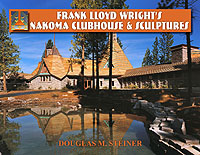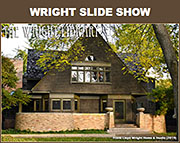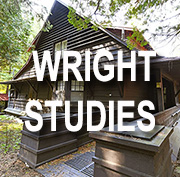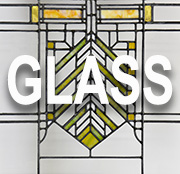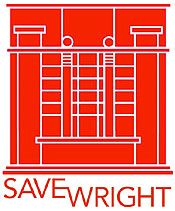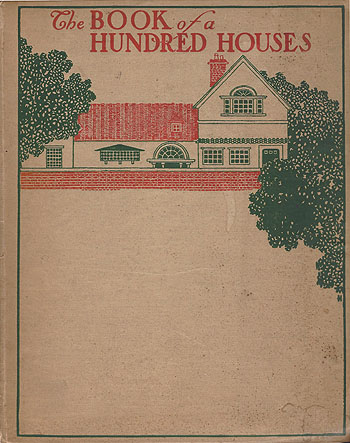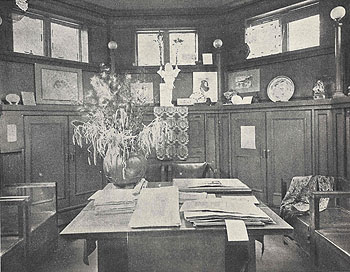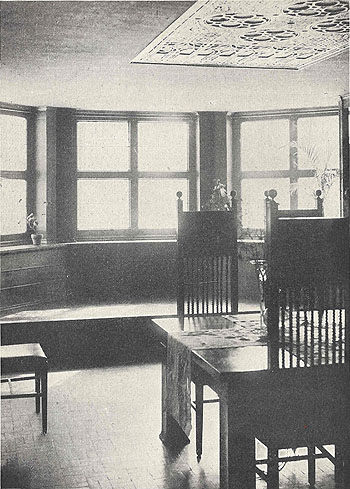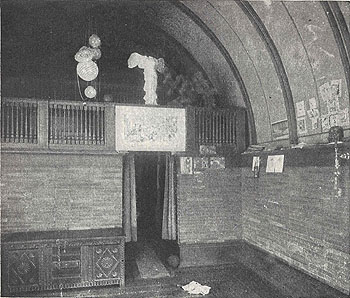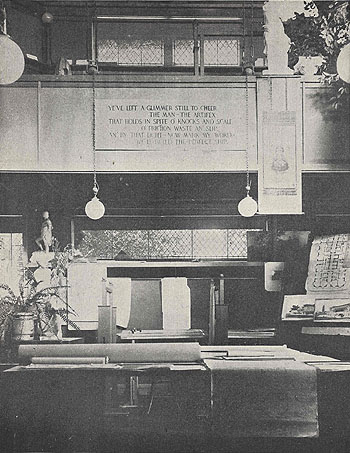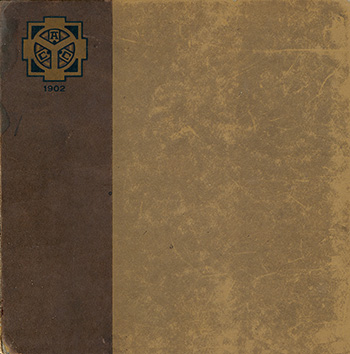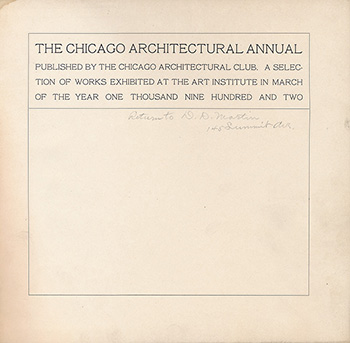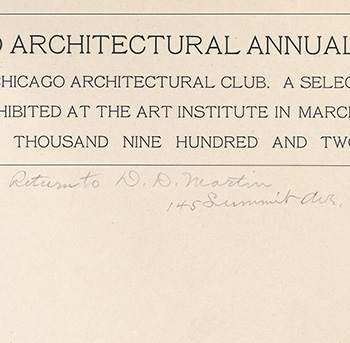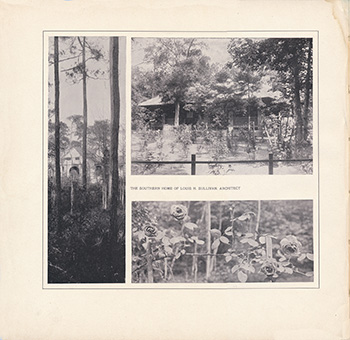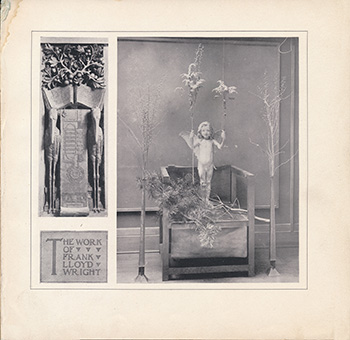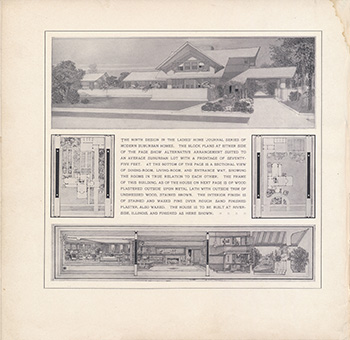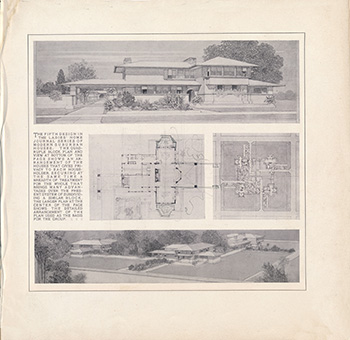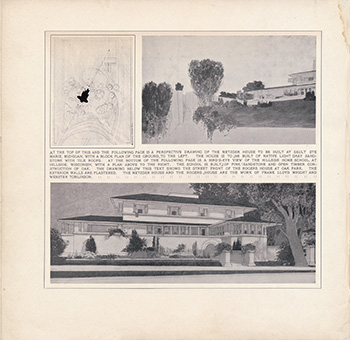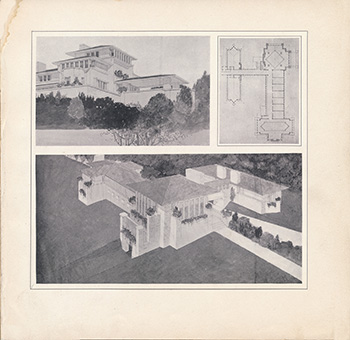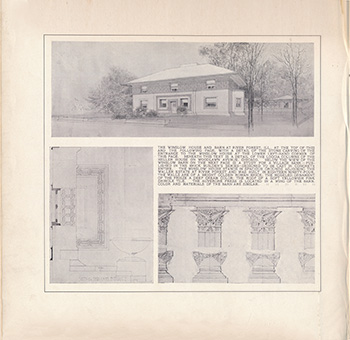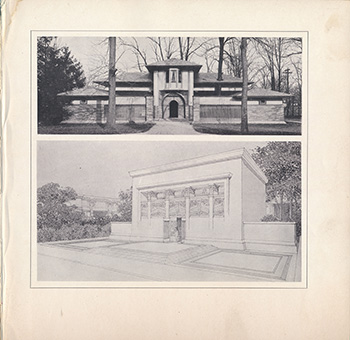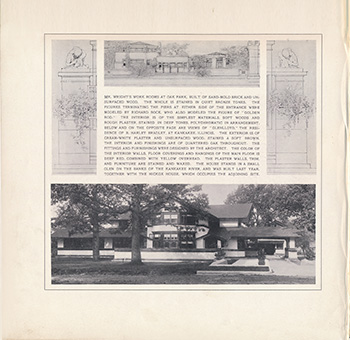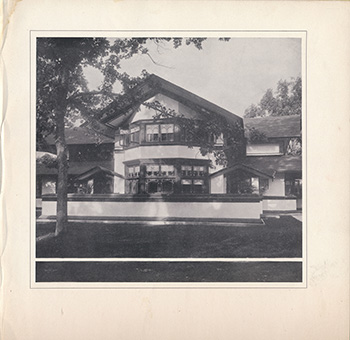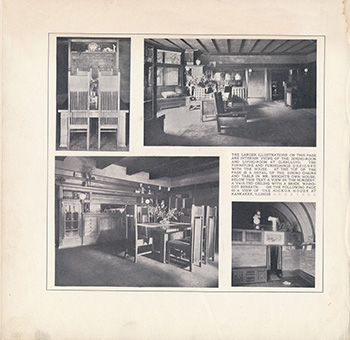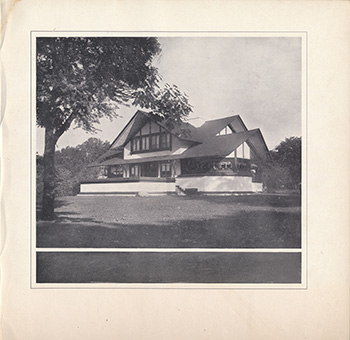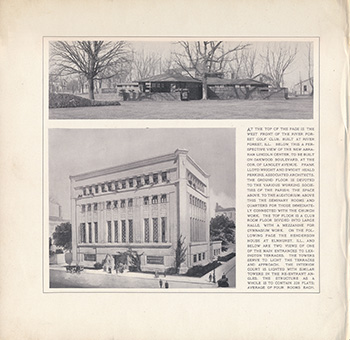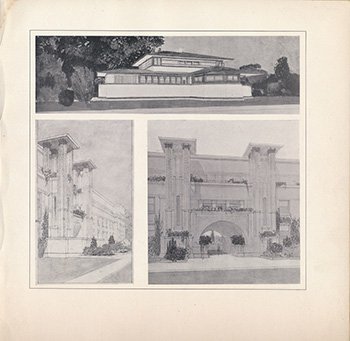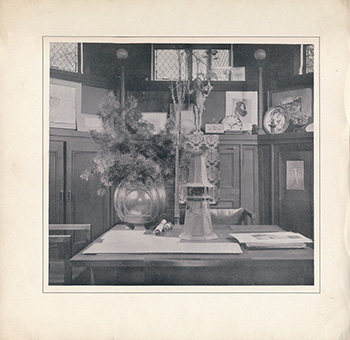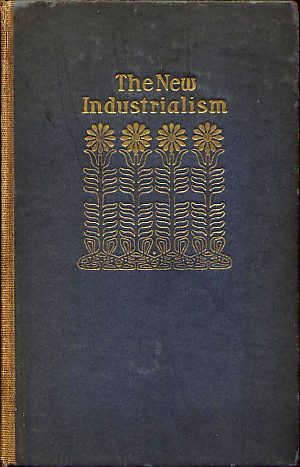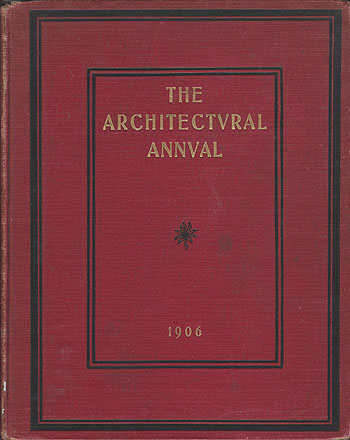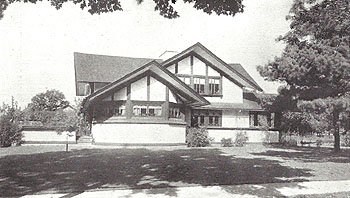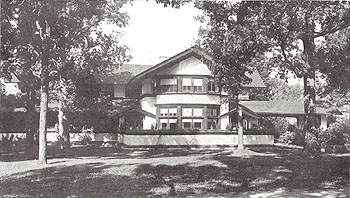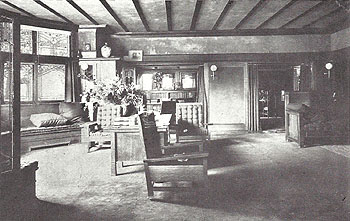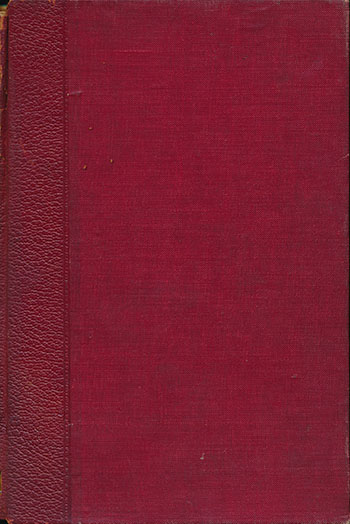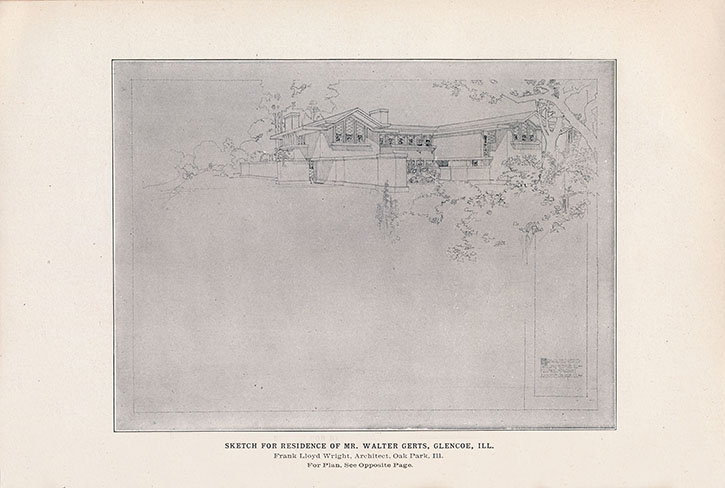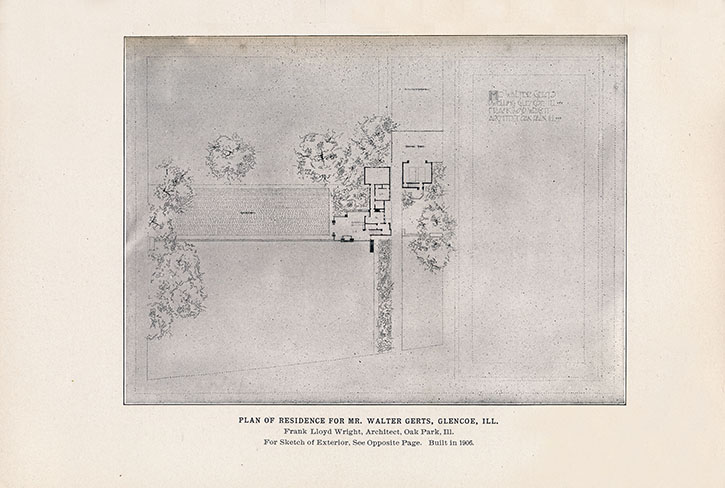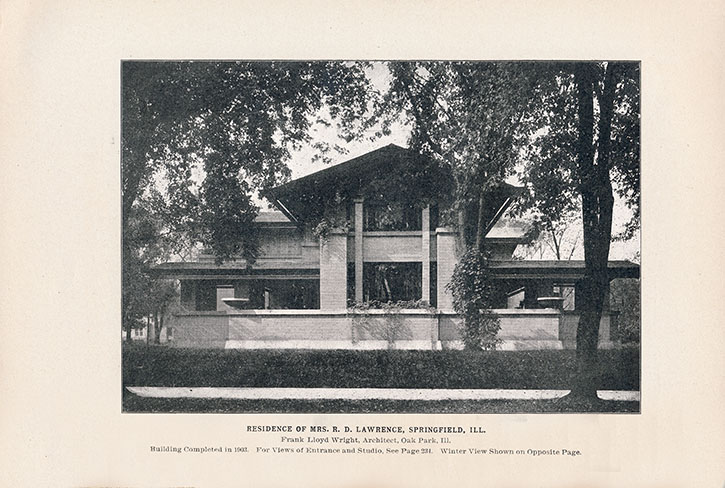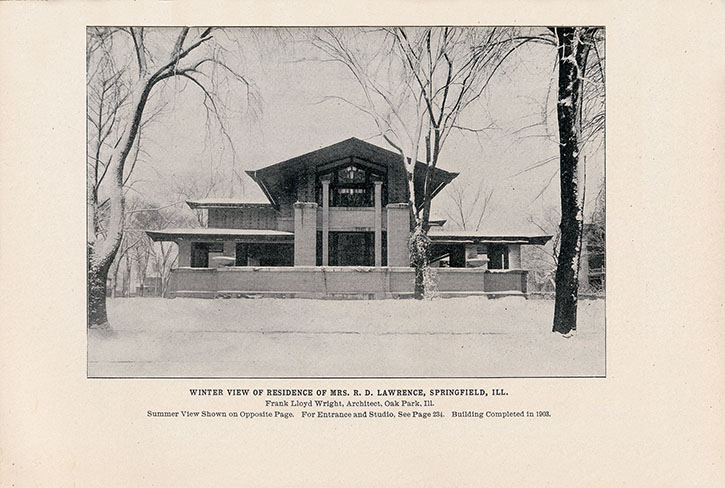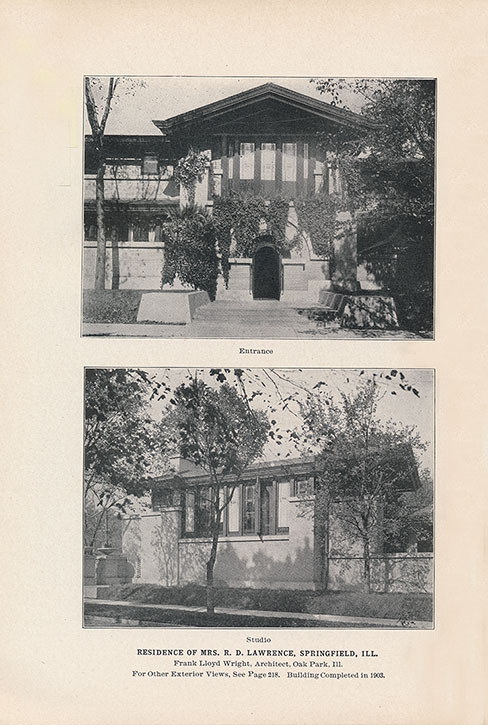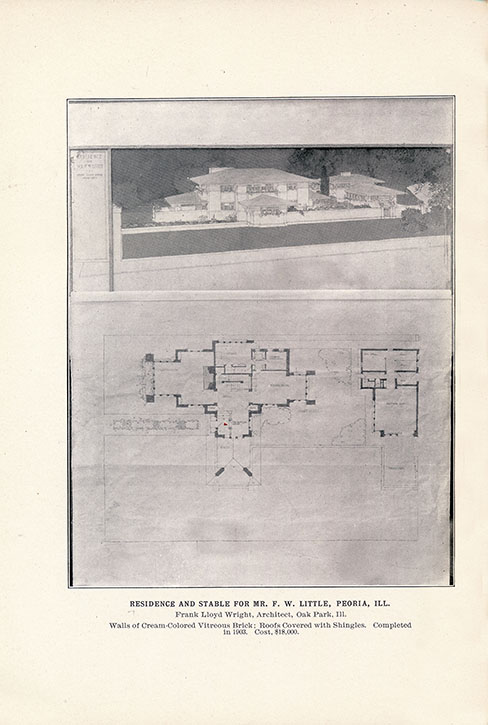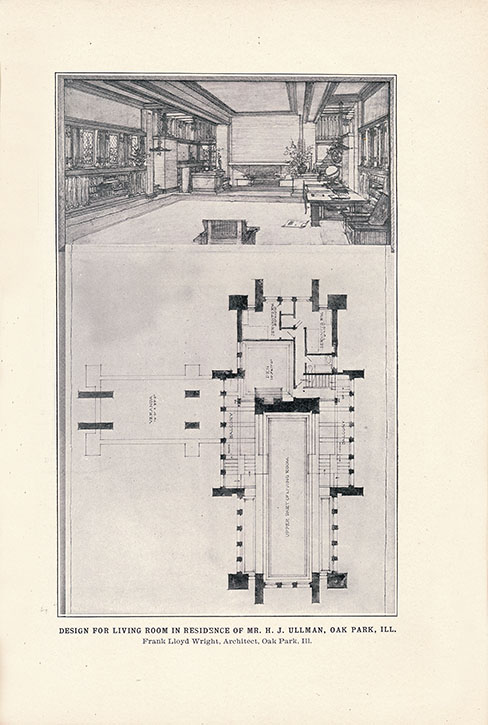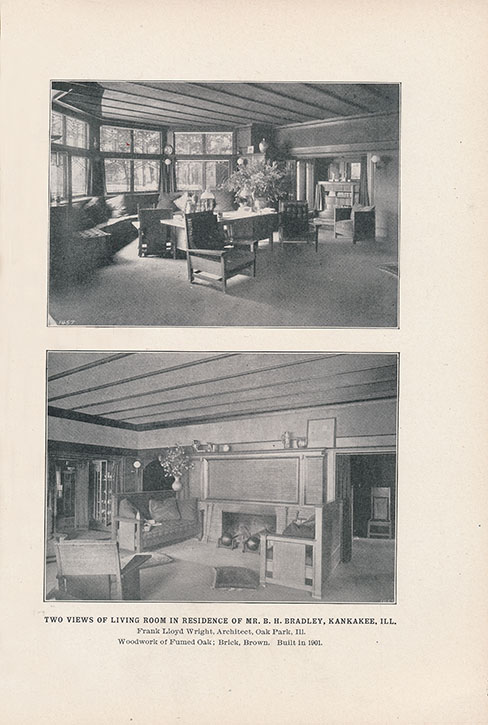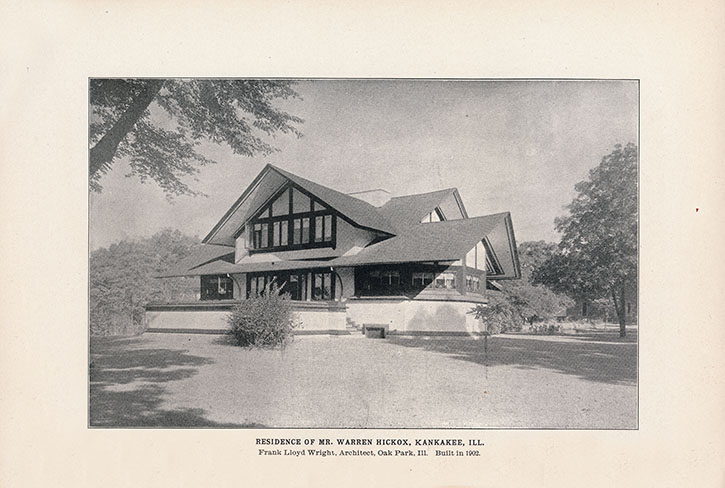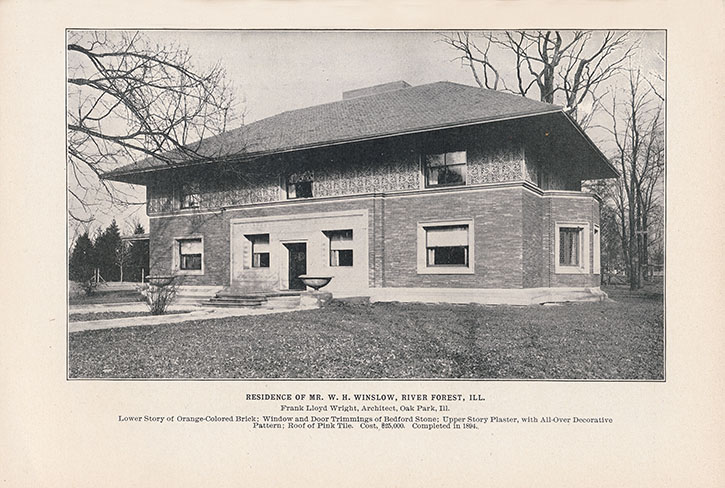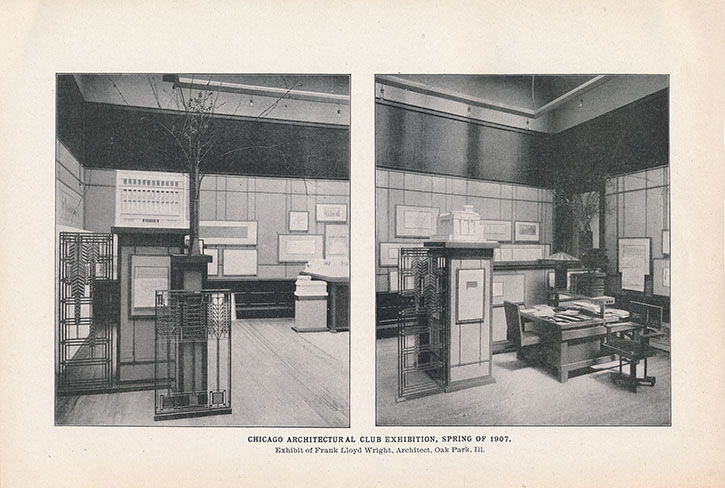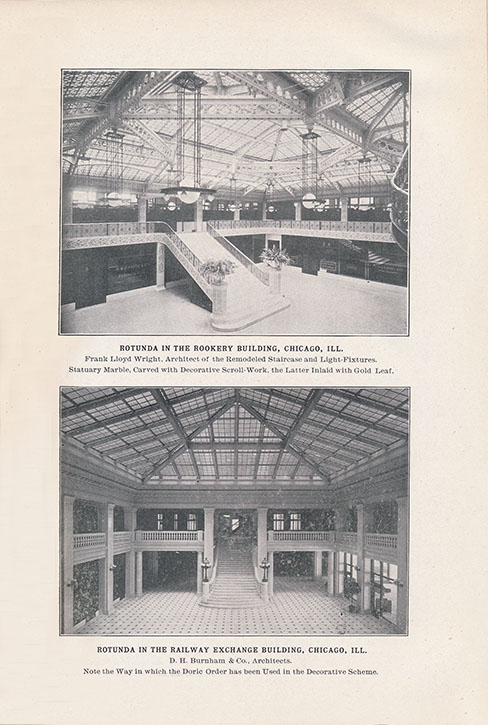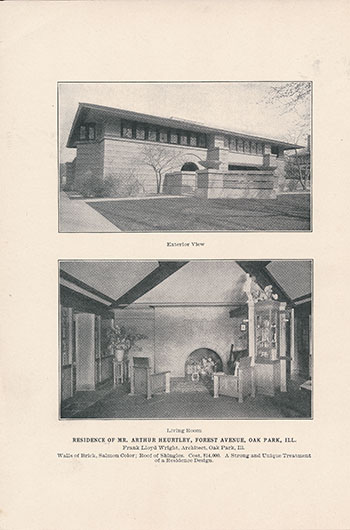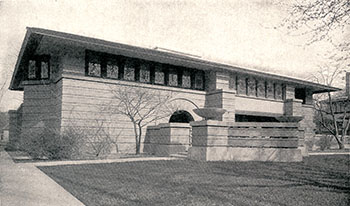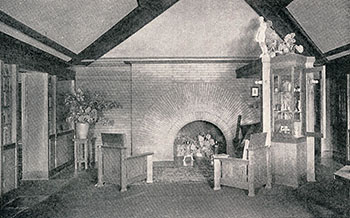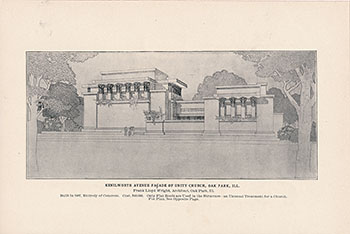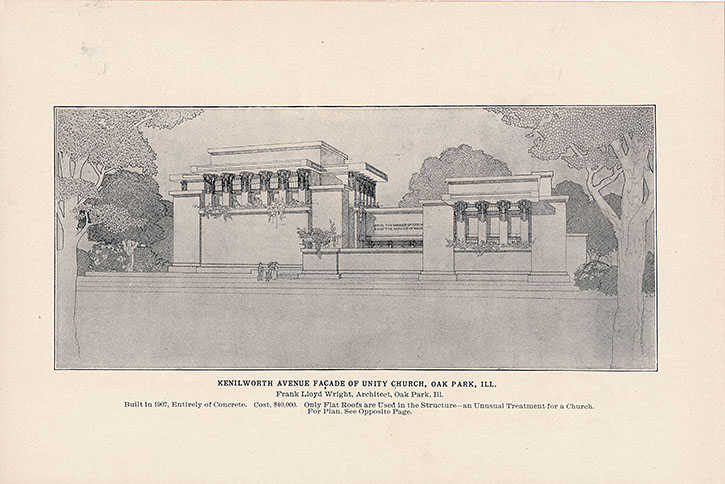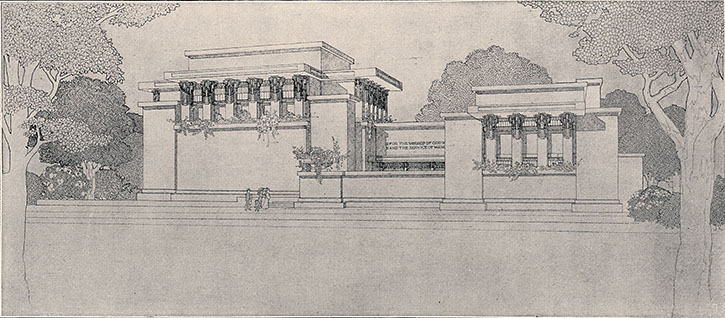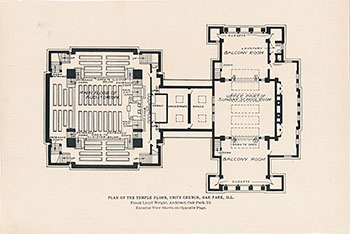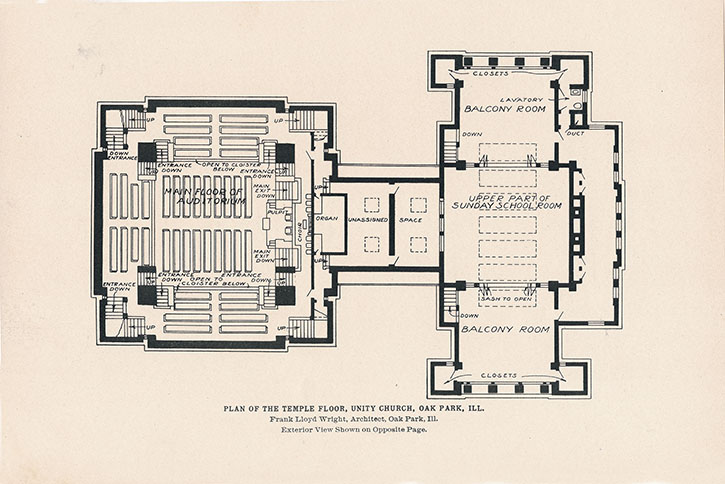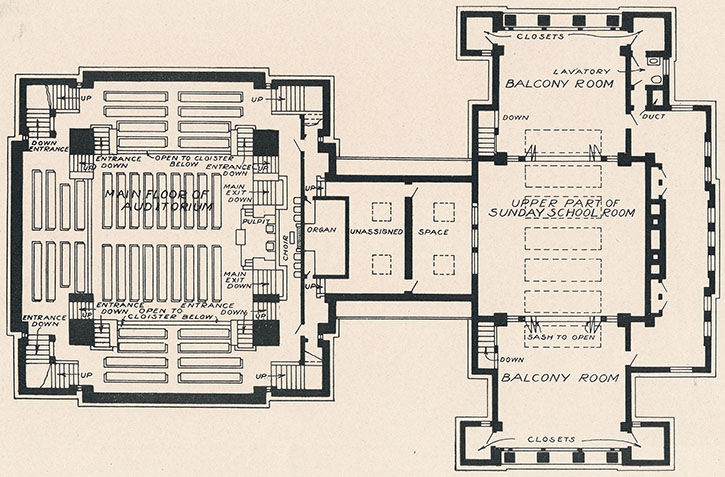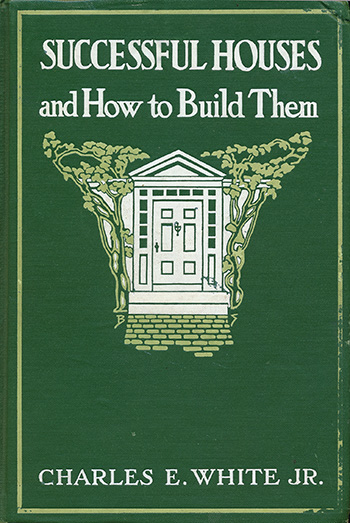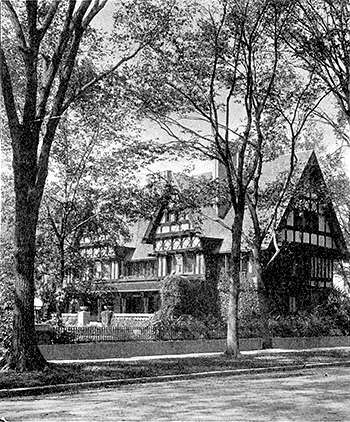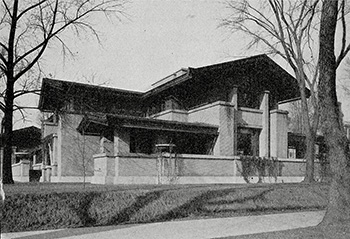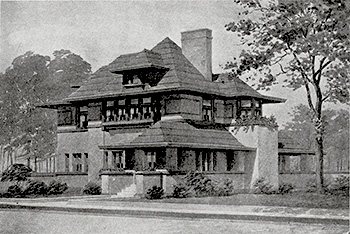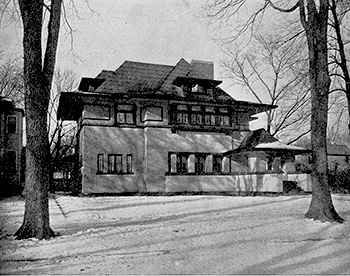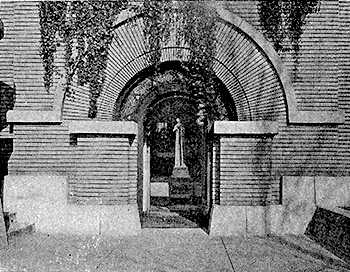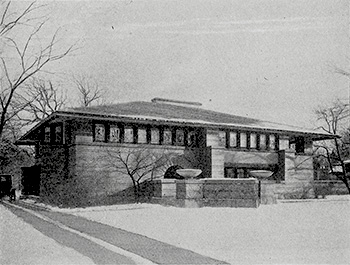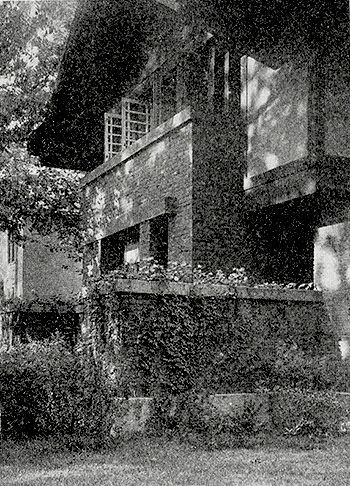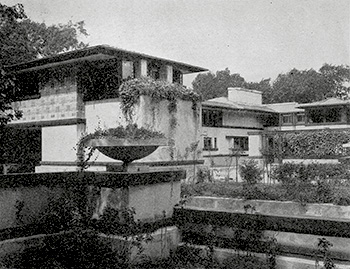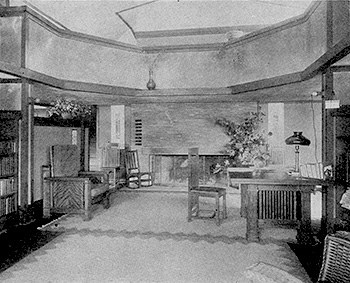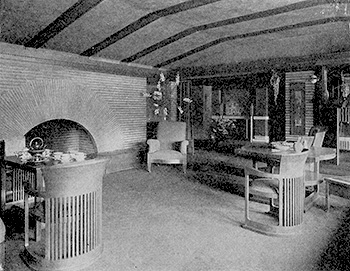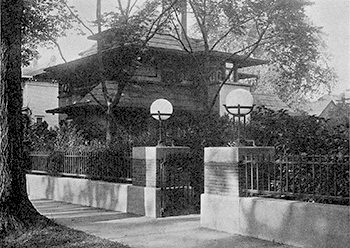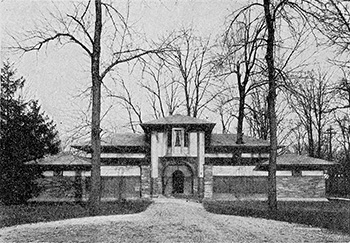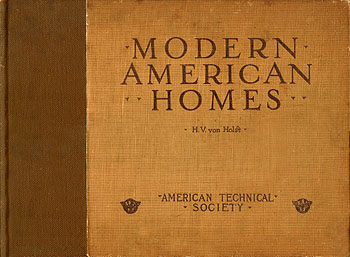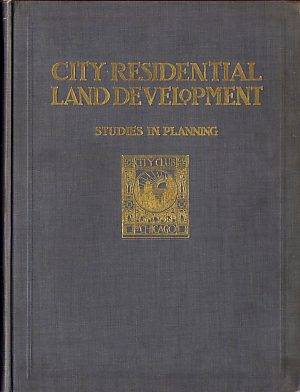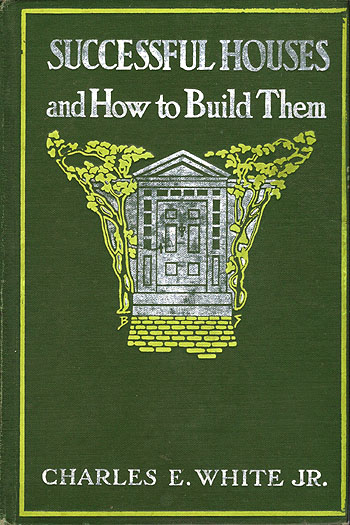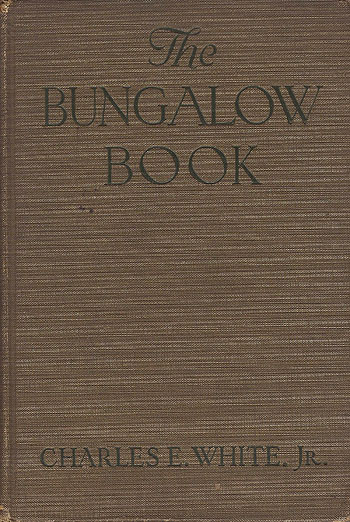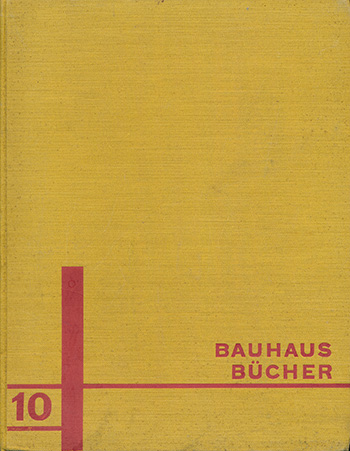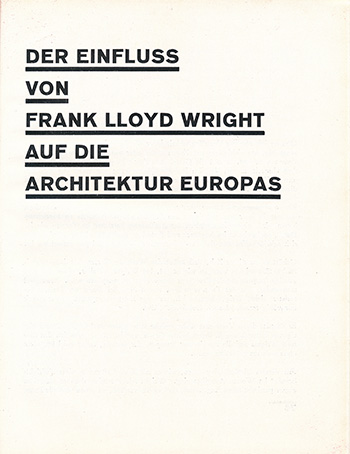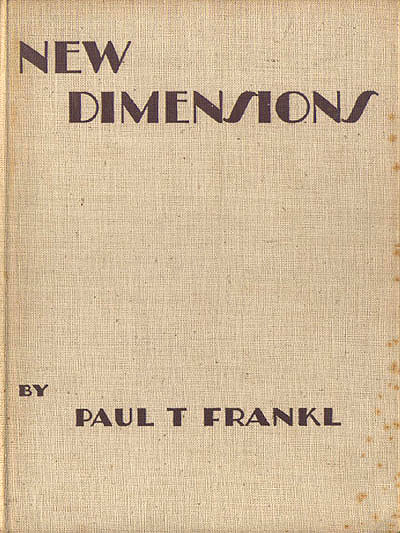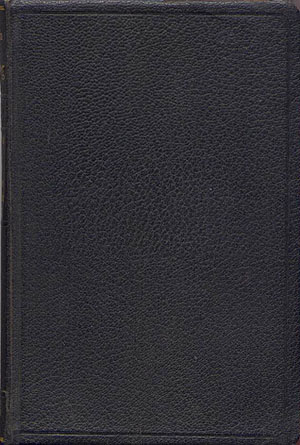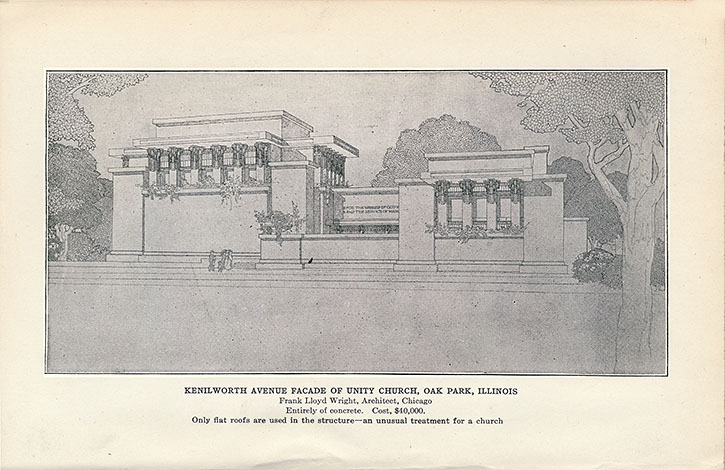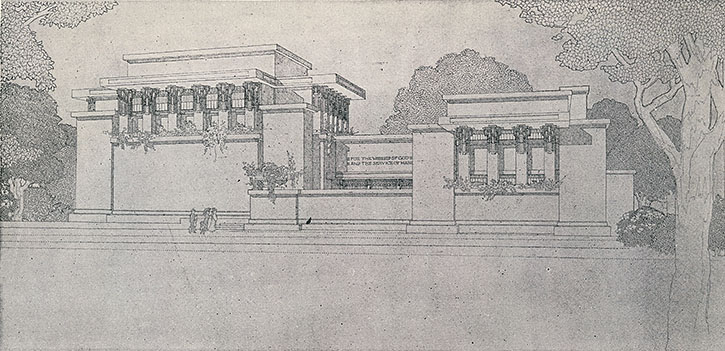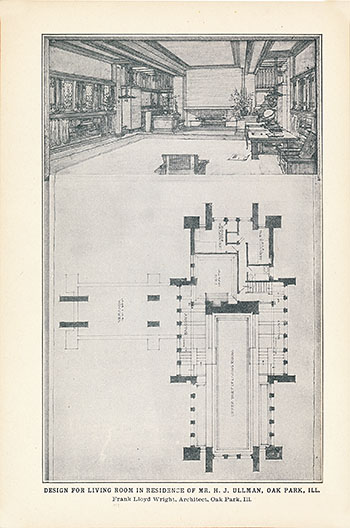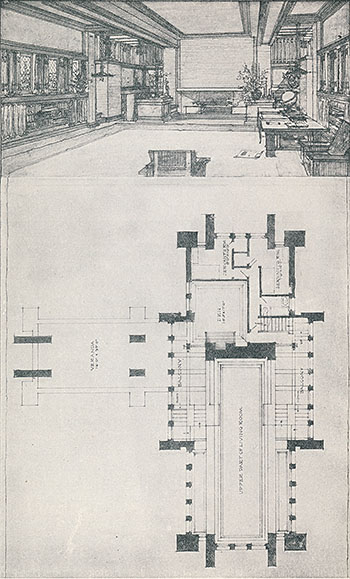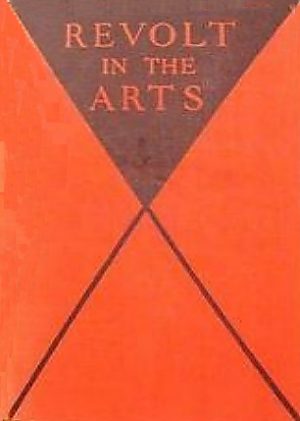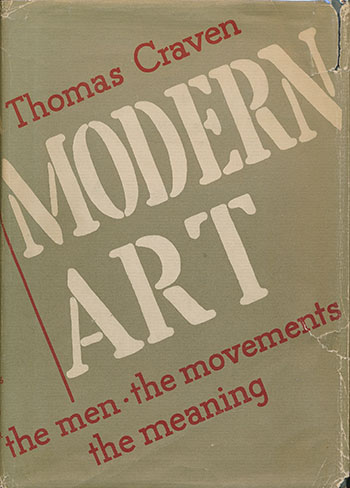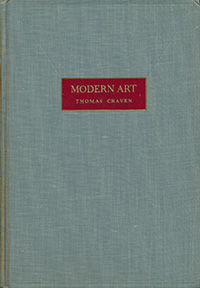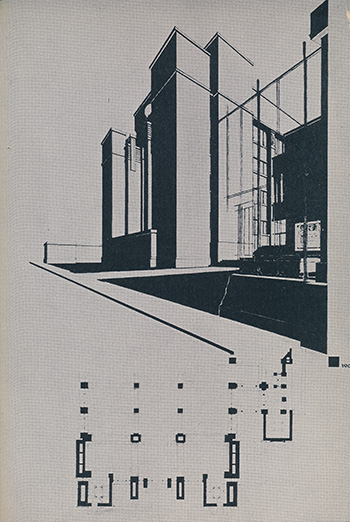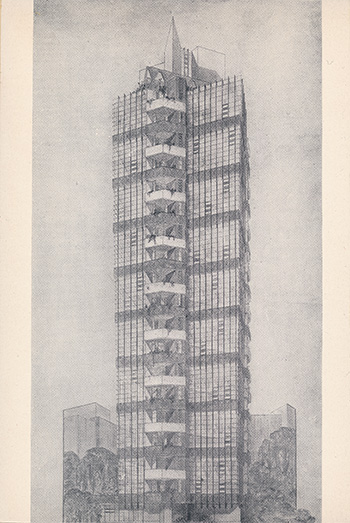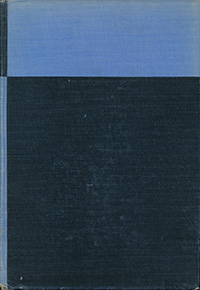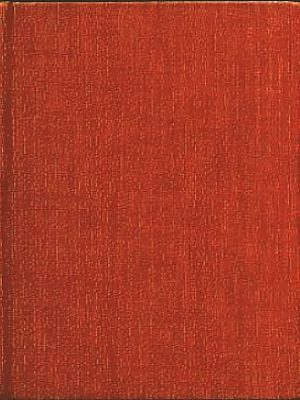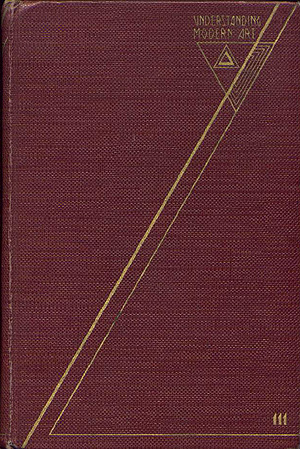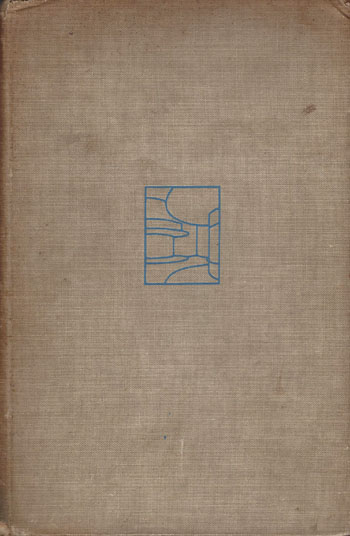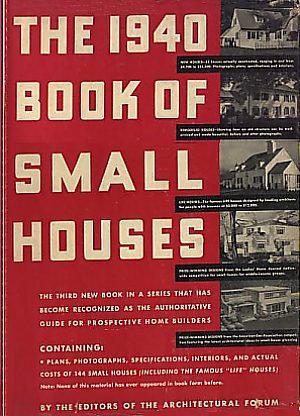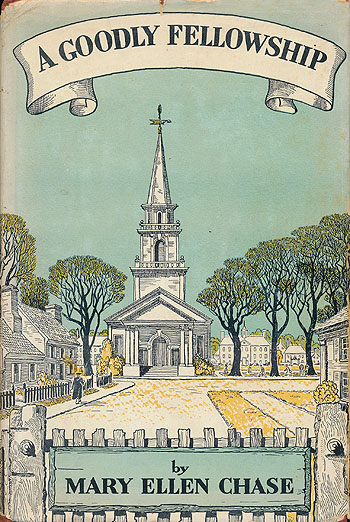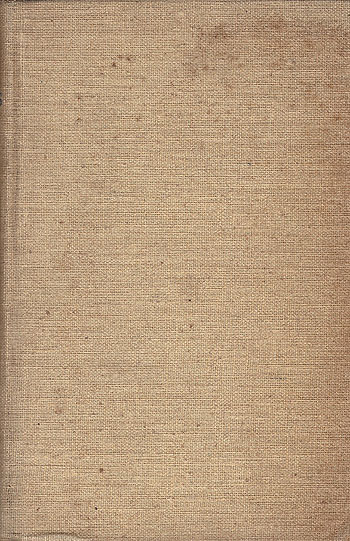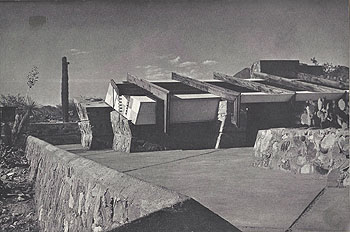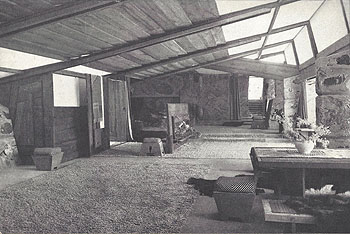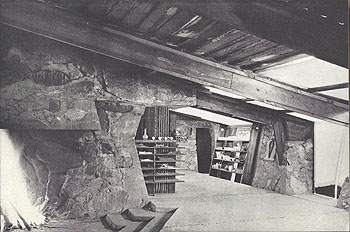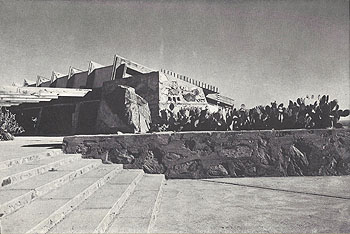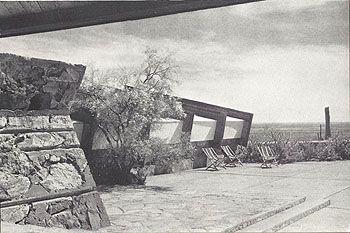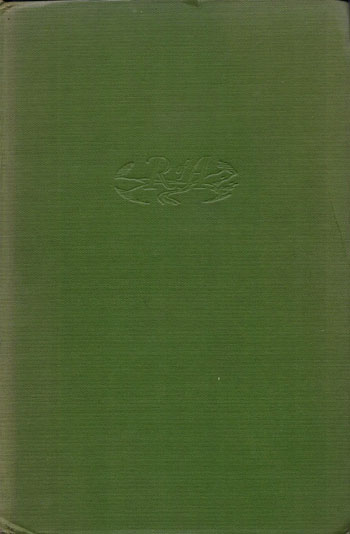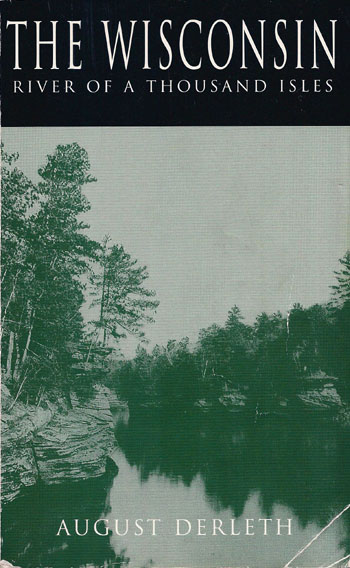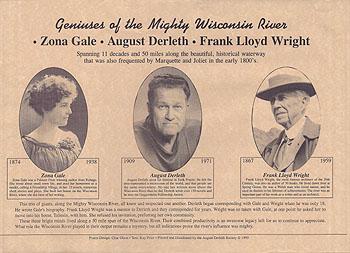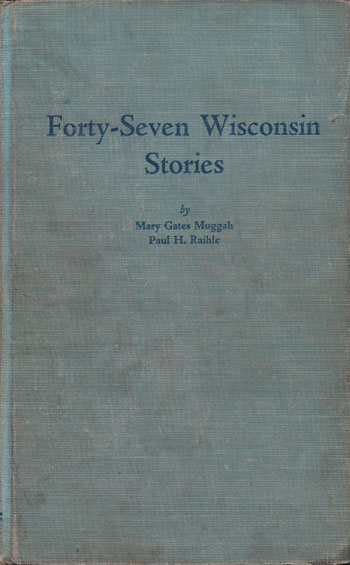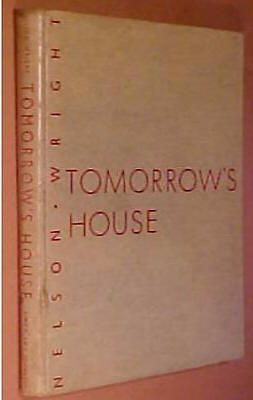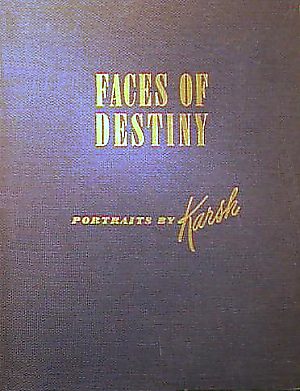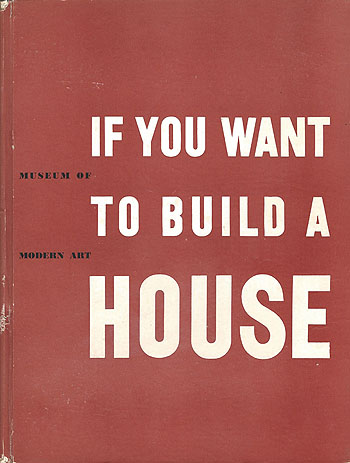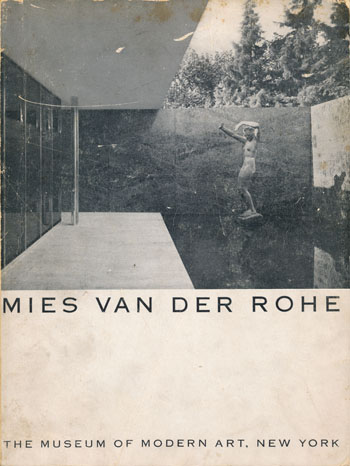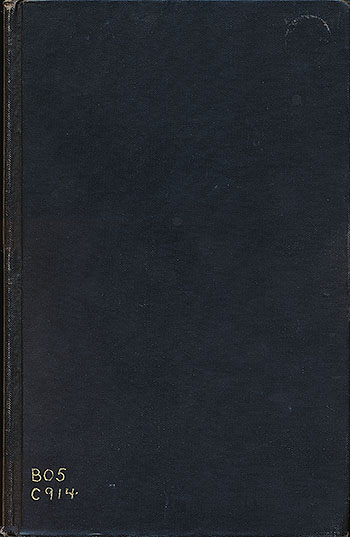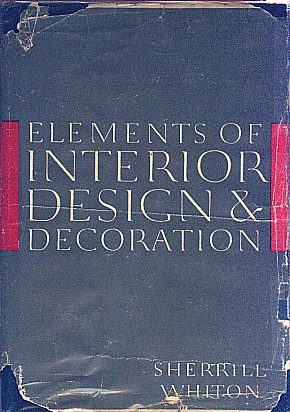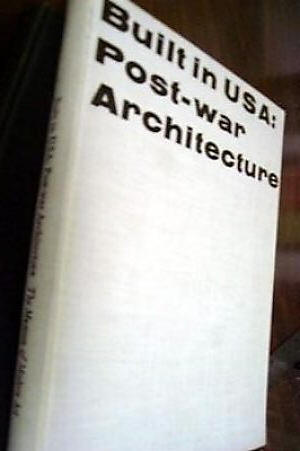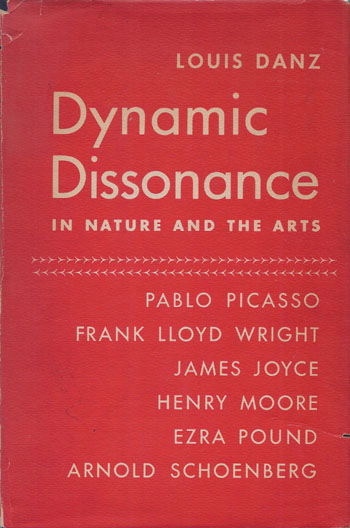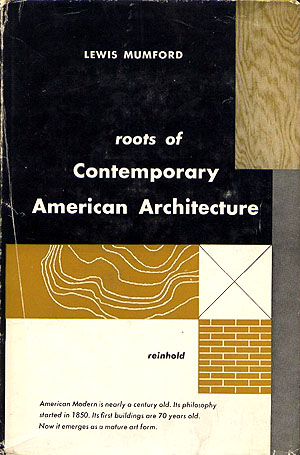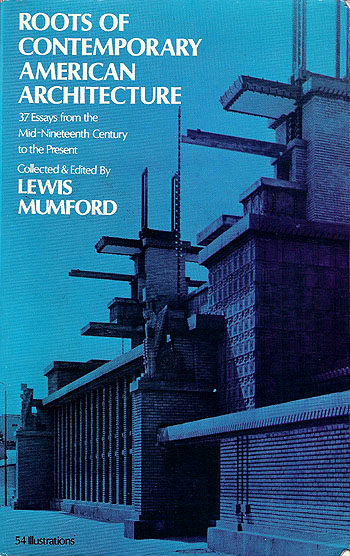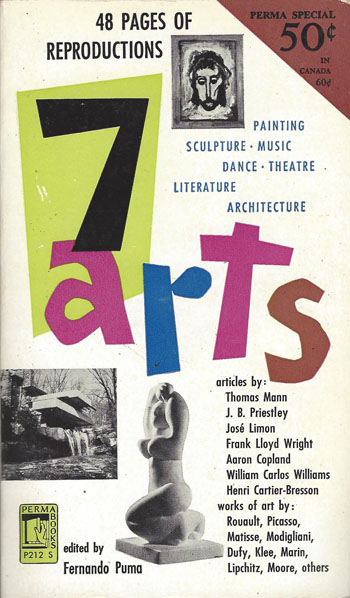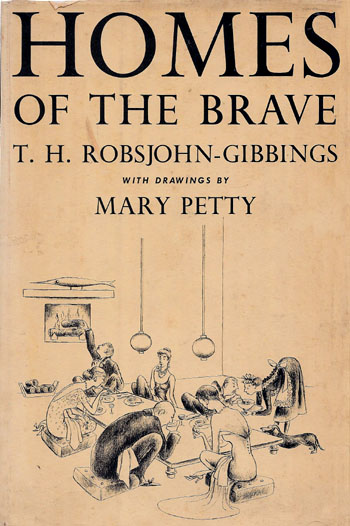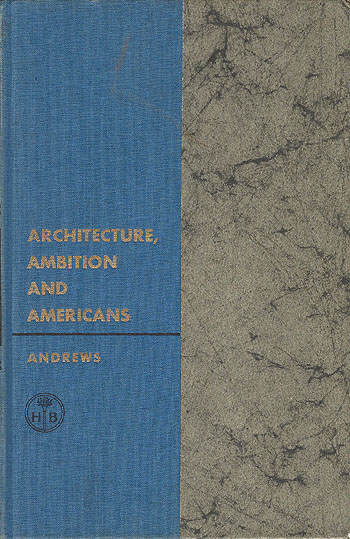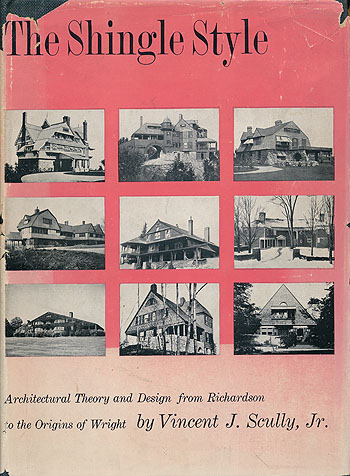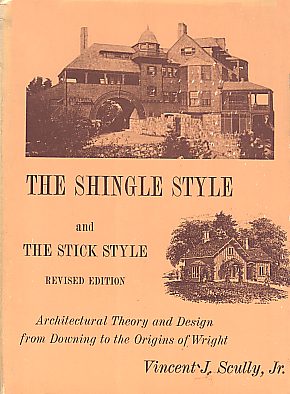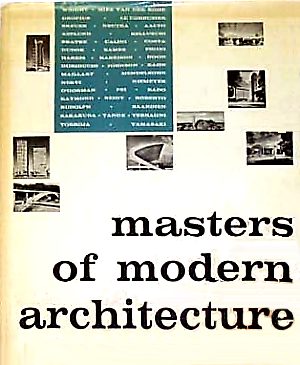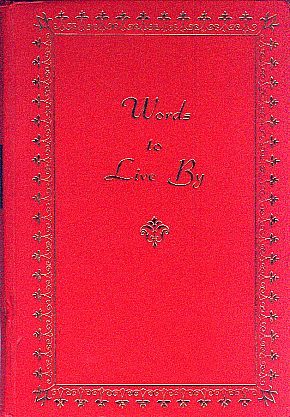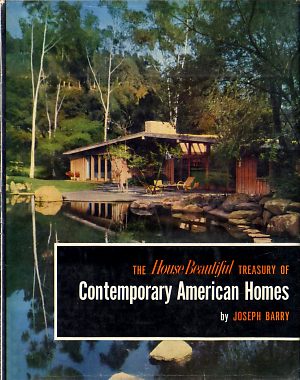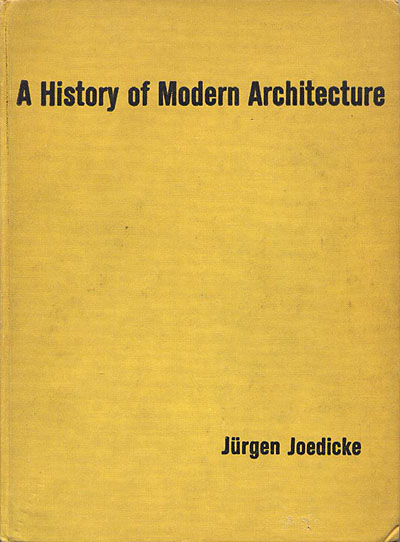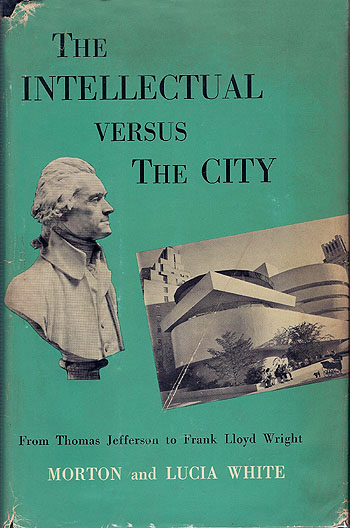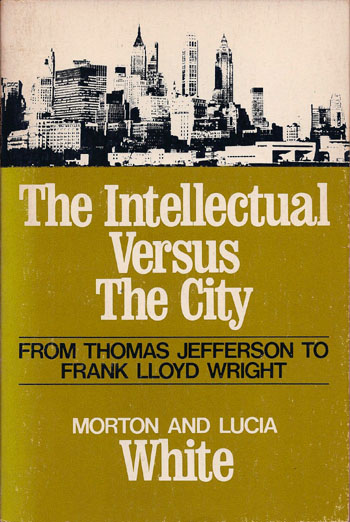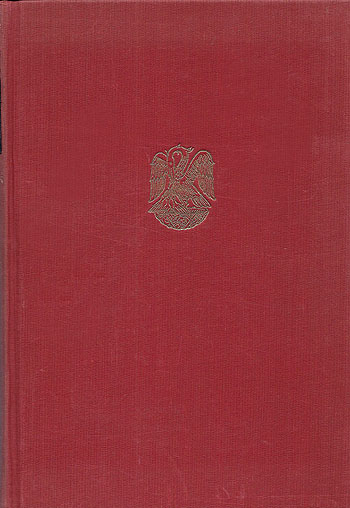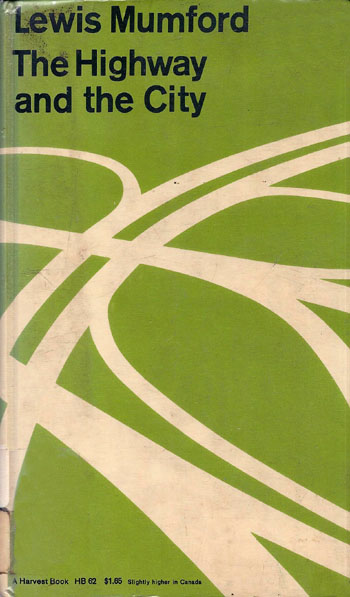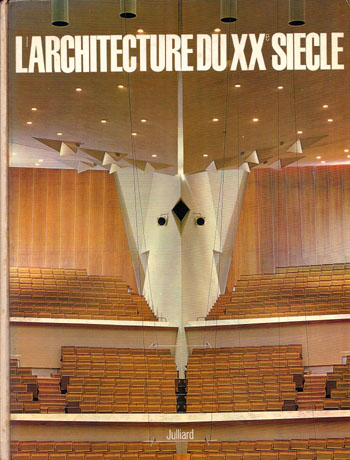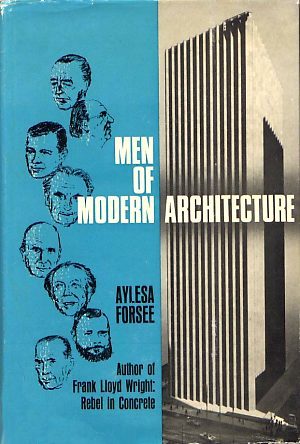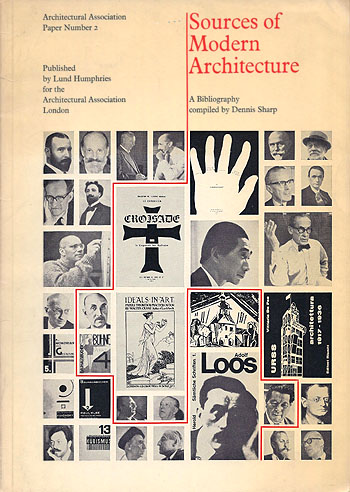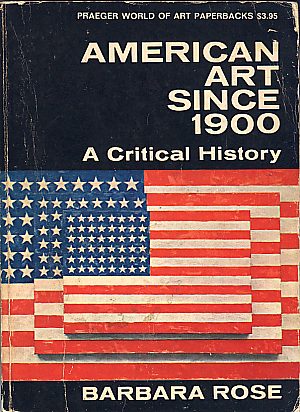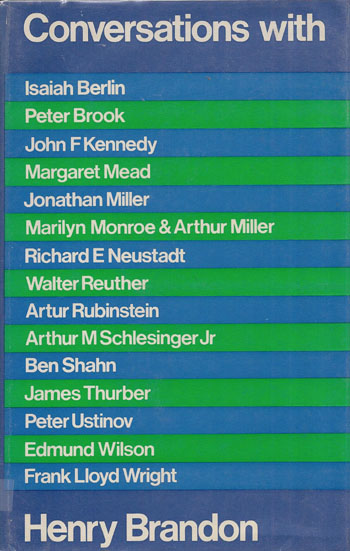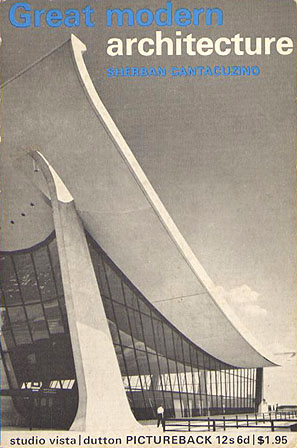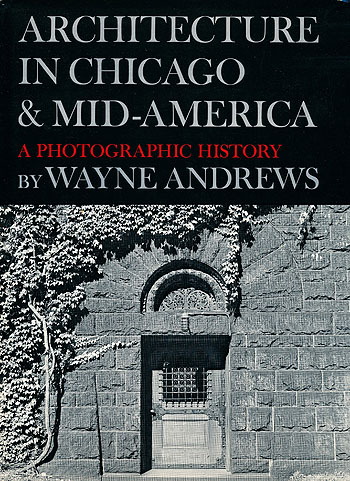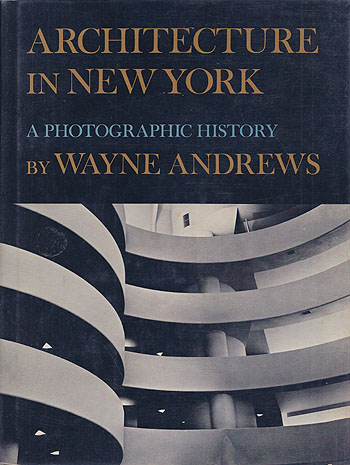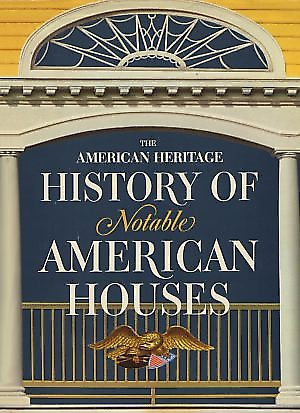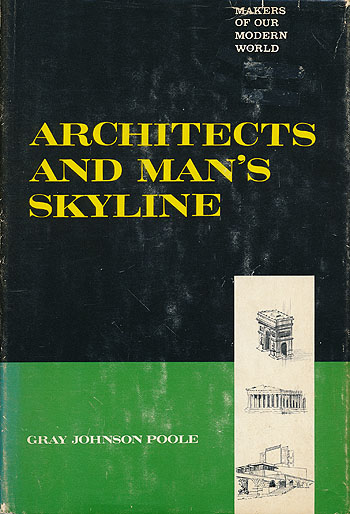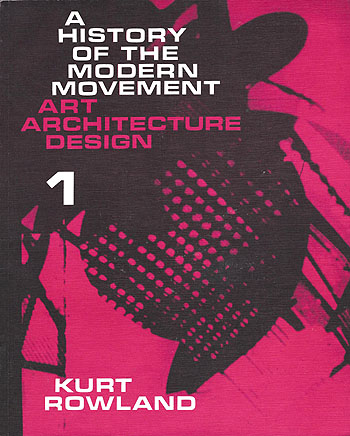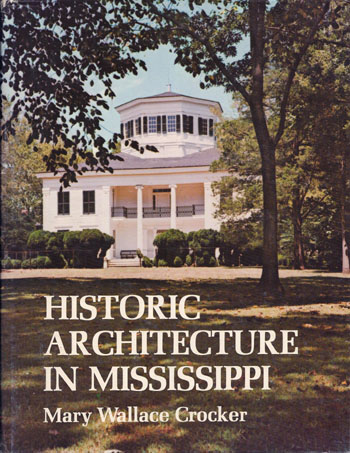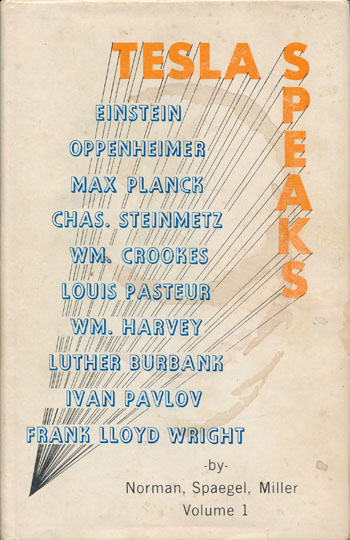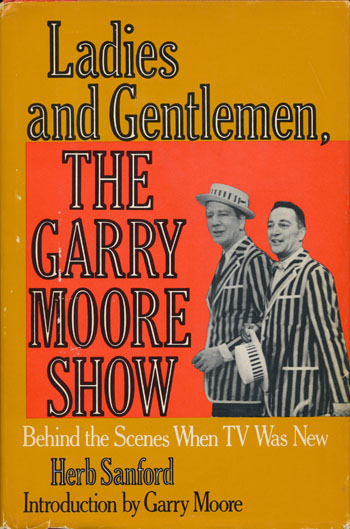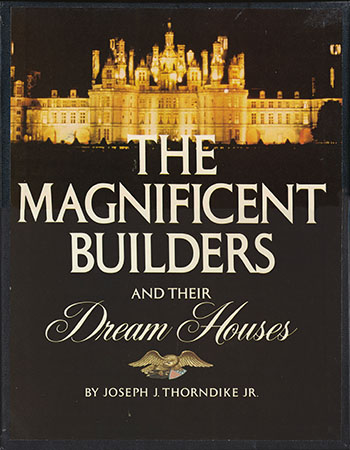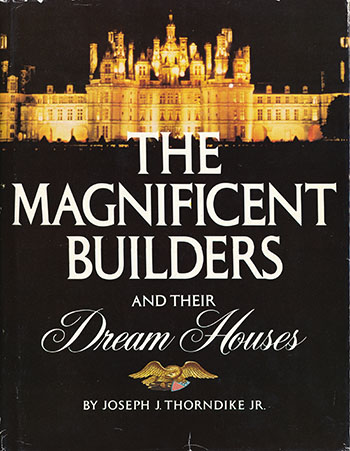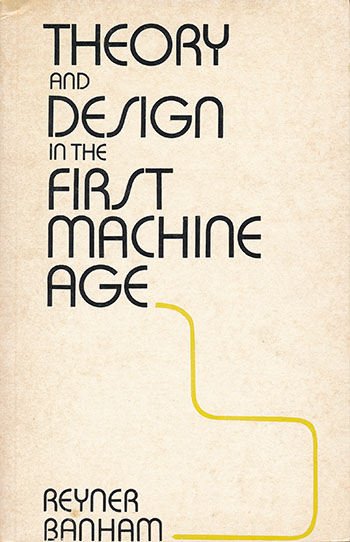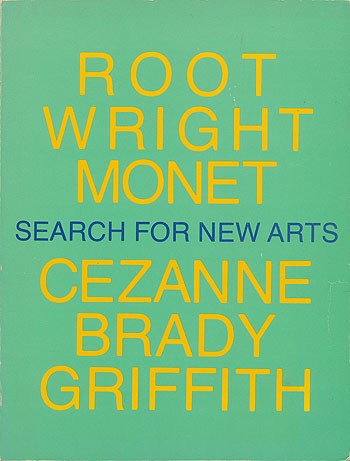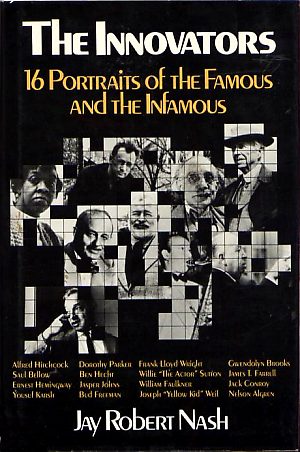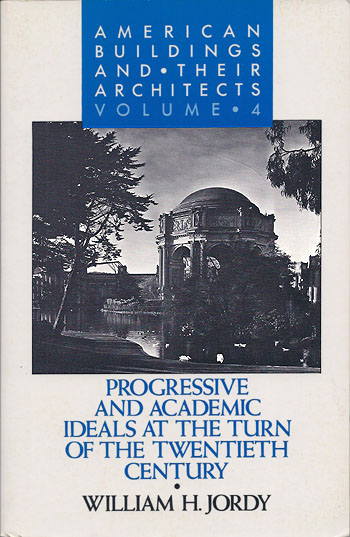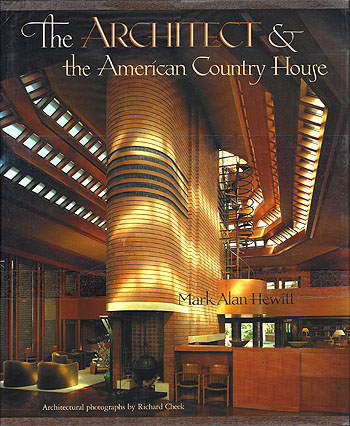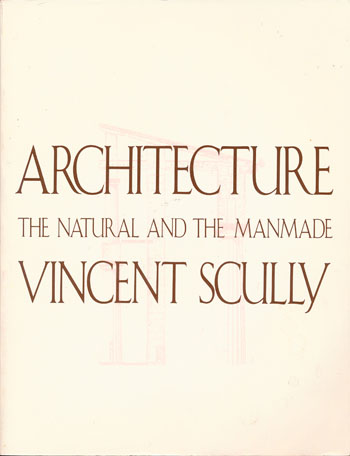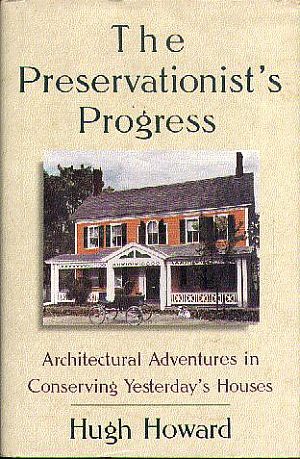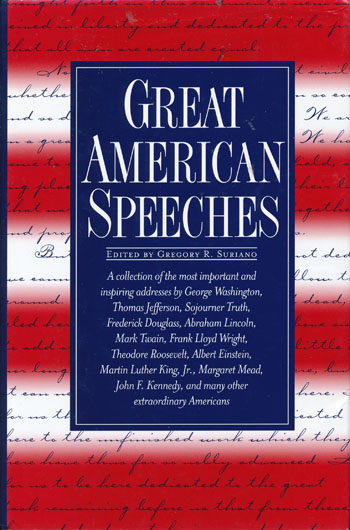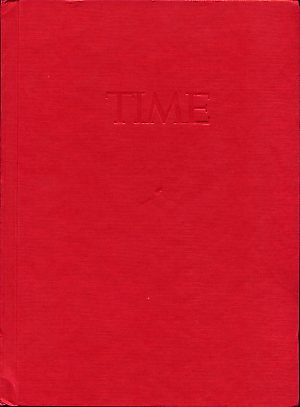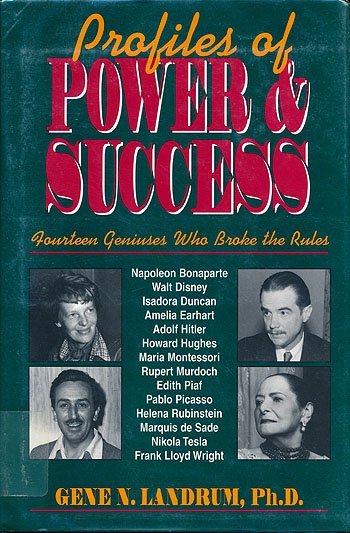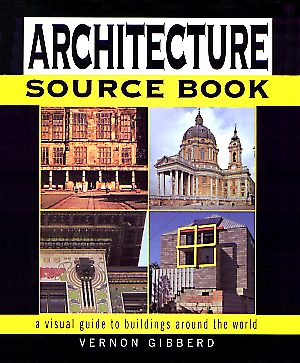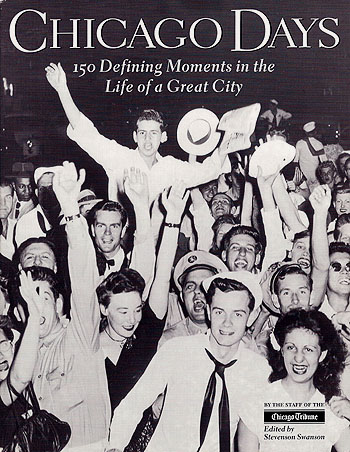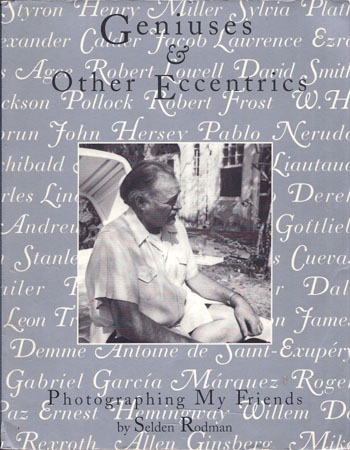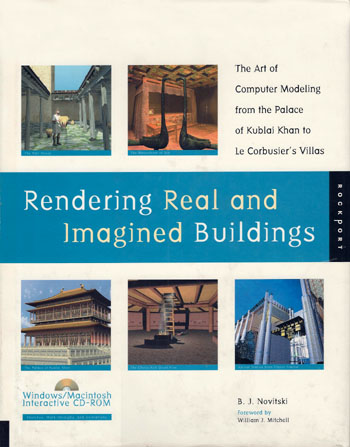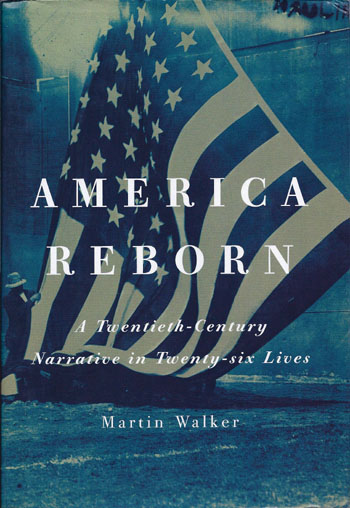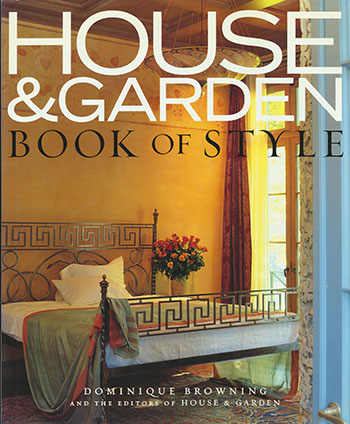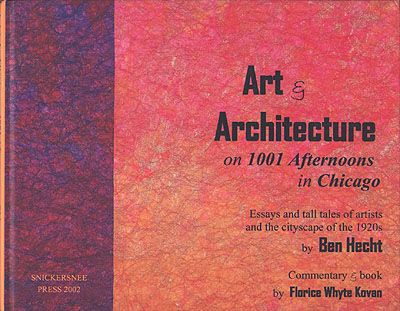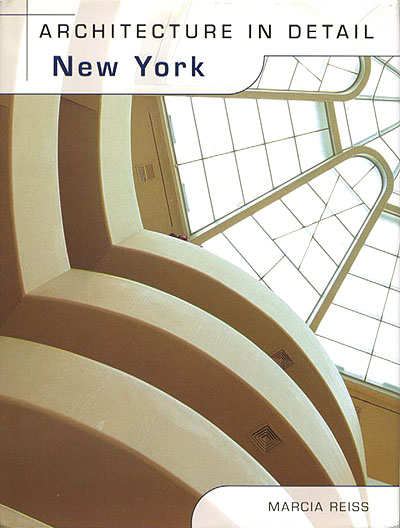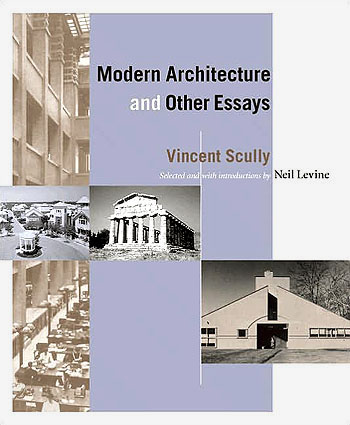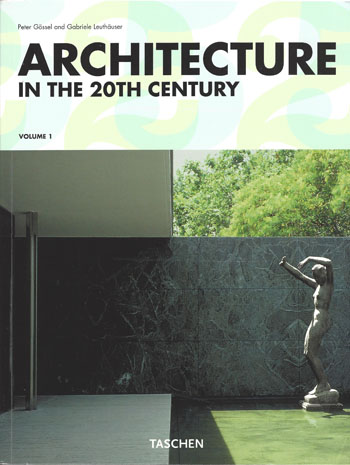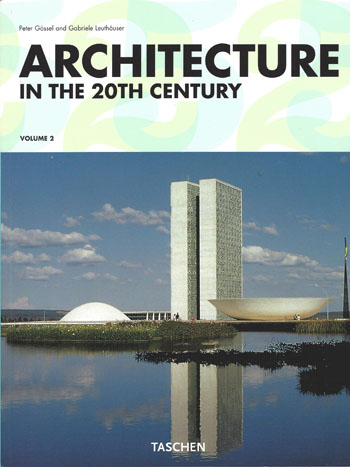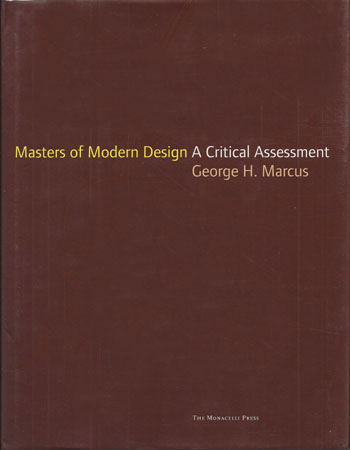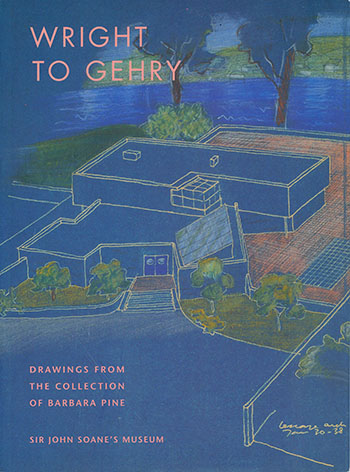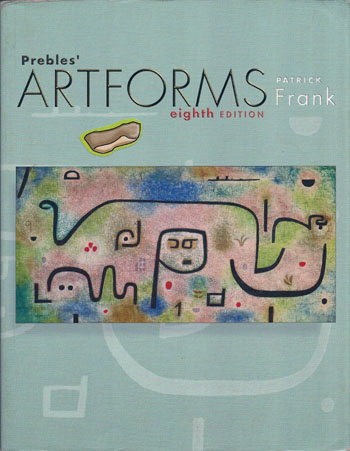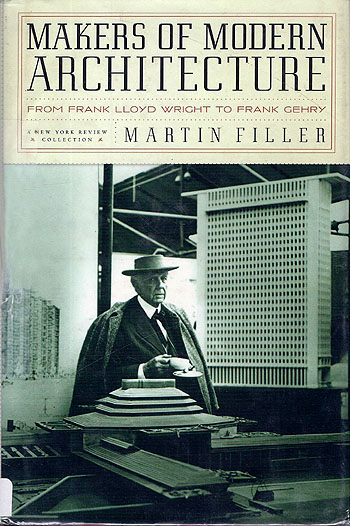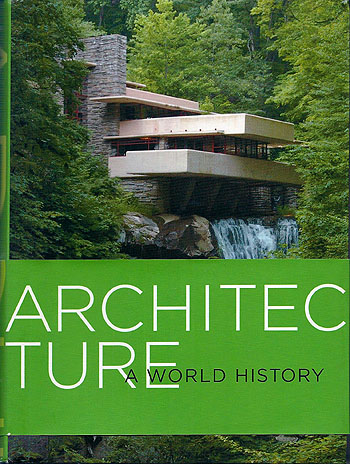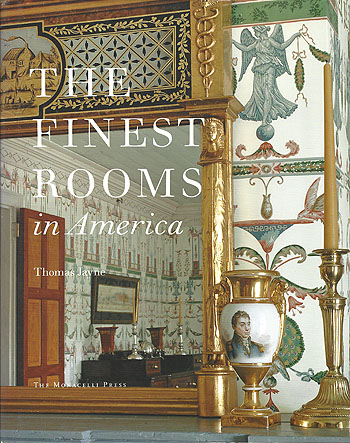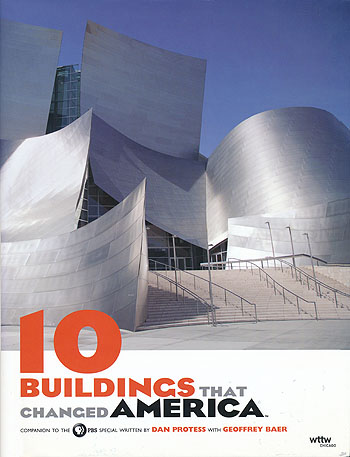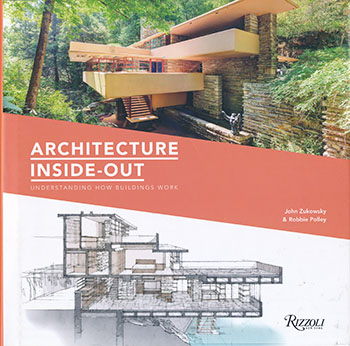
SUPPORT THE
WRIGHT LIBRARY
PROCEEDS FROM EVERY SALE GOES TO SUPPORT THE WRIGHT LIBRARY.
CLICK TO ORDER.
WE PROUDLY SUPPORT THE FRANK LLOYD WRIGHT FOUNDATION
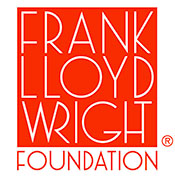
WE PROUDLY SUPPORT THE FRANK LLOYD WRIGHT BUILDING CONSERVANCY
WE PROUDLY SUPPORT FALLINGWATER
AND THE WESTERN PENNSYLVANIA CONSERVANCY

CHAPTERS ON & BY FRANK LLOYD WRIGHT
Date: 1902
Title: The Book of a Hundred Houses. A collection of Pictures, Plans and Suggestions for Householders (Hard Cover) (Published by Herbert S. Stone & Company, Eldridge Court, Chicago. Herbert S. Stone also published House Beautiful. Top edge trimmed and gilt, others uncut.)
Author: Editor: Dow, Joy Wheeler; Chapter written by: Granger, Alfred H.
Description: The article "An Architects Studio " by Alfred H. Granger was first published in the December 1899 issue of House Beautiful. It is reprinted in this volume. "An Architects Studio. When one attempts to describe almost any modern building, the first question to be asked is, "'What style?" ...One of the most radical of these opponents is Mr. Frank L. Wright, whose house and studio I have the privilege of describing... One's first impression of the dining-room is its simplicity, no rugs, no curtains, and only the necessary furniture, which, however, is in perfect harmony with the room. One entire end of the room opposite the fireplace is practically of glass, laid in leading of a very delicate design, which was evidently inspired by the lotus flower. The harmony of color between the brown and the red is perfect, and is accentuated (if one can accentuate a harmony) by the color of the walls and ceiling, which are covered with arras of a soft brown, and which give to the entire room a golden tone such as one sees in a rich sunset. In the center of the ceiling is a design of exquisite tracery, through which at night a soft light filters, and gives to the whole room a warm, rich glow. Includes 5 photographs. Note: Listed in Sweeney, but not seen by the author. (First Edition) (Sweeney 35B)
Size: 7 x 8.75
Pages: Pp 207-214
S#: 0035.00B.0317
Date: 1902 Title: The Chicago Architectural Annual. A Selection of Work Exhibited at the Art Institute in March of the Year One Thousand Nine Hundred and Two. (Published by The Chicago Architectural Club.)
Author: Chicago Architectural Club
Description: There is no introductory text. Title Page: The Chicago Architectural Annual. Published by The Chicago Architectural Club. A Selection of Work Exhibited at the Art Institute in March of the Year One Thousand Nine Hundred and Two.
Hand written by Darwin D. Martin on the title page: “Return to D. D. Martin. 145 Summit Ave.” This copy was owned by Darwin D. Martin. In 1888, Darwin Martin and Isdabelle Reidpath pledge to marry and build a house at 145 Summit Ave, now 151 Summit Ave. 151 Summit is just north of the Martin Complex on the east side of the street. The Martins lived there until they moved into their Frank Lloyd Wright designed house. Darwin D. Martin House, Cultural Landscape Report, 2015, p.134.
Some of the notible pages: Pages 2-5: The work of Dwight Perkins; Pages 8-13: The work of R. C. Spencer, Jr.; Pages 26-29: The work of Howard Shaw; Pages 30-36: The work of Louis Sullivan; Page 30: The Southern Home of Louis H. Sullivan, Architect. Attributed to Frank Lloyd Wright (1890 - S.005-006); Pages 38-39: The work of George W. Maher; Page 41: The work of Wm. E. Drummond; Pages 43-56: The Work of Frank Lloyd Wright. There are 39 photographs and illustrations of Wright's work. Two copies, one rebound by University of Tampa. (First Editions) (Sweeney 49)Size: 9.25 x 9.5
Pages: Pp 56 (Unpaged)
S#: 0049.00.0215, 0049.00.1124
Left: Title Page: The Chicago Architectural Annual. Published by The Chicago Architectural Club. A Selection of Work Exhibited at the Art Institute in March of the Year One Thousand Nine Hundred and Two.
Right: Hand written by Darwin D. Martin on the title page: “Return to D. D. Martin. 145 Summit Ave.” This copy was owned by Darwin D. Martin. In 1888, Darwin Martin and Isdabelle Reidpath pledge to marry and build a house at 145 Summit Ave, now 151 Summit Ave. 151 Summit is just north of the Martin Complex on the east side of the street. The Martins lived there until they moved into their Frank Lloyd Wright designed house. Darwin D. Martin House, Cultural Landscape Report, 2015, p.134.
Left: Page 30: The Southern Home of Louis H. Sullivan, Architect. Attributed to Frank Lloyd Wright (1890 - S.005-006)
Right: Page 43: The Work of Frank Lloyd Wright.
Left: Page 44: The ninth design in the Ladies' Home Journal Series of Modern Suburban Homes. The block plans at either side of the page show alternative arrangement suited to an average suburban lot with a frontage of seventy-five feet. At the bottom of the page is a sectional view of dining-room, living-room, and entrance way, showing the rooms in true relation to each other. The frame of this building, as of the house on next page is of wood plastered outside upon metal lath with outside trim of undressed wood, stained brown. The interior finish is of stained and waxed pine over rough sand finished plaster, also waxed. The house is to be built at Riverside, Illinois, and finished as here shown.
Right: Page 45: “The fifth design in the Ladies' Home Journal Series of Modern Suburban Houses. The quadruple block plan and view at bottom of the page shows an arrangement of the houses that gives privacy to each house-holder, securing at the same time a breadth of treatment for the whole that brings many advantages over the present system of subdividing a similar block. The larger plan at the center of the page shows the detailed arrangement of the plan used as the basis for the group.
Page 46-47: At the top of this and the following page is a perspective drawing of the Metzger house to be built at Sault Ste Marie, Michigan, with a block plan of the ground to the left.The house is to be built of native light gray sand-stone with tile roofs. At the bottom of the following page is a bird's-eye view of the hillside home school, at Hillside, Wisconsin, with a plan above to the right. The school is built of pink sandstone and open timber construction of oak. The drawing below this text shows the street front of the Rogers House at Oak Park. Exterior walls are plastered. The Metzger House and the Rogers House are the work of Frank Lloyd Wright and Webster Tomlinson.
Page 48-49: The Winslow House and Barn at River Forest, Ill., at the top of this and the following page, with a detail of the stone carving of the entrance to the Winslow House at the lower left-hand corner of this page. Beneath this text is a detail of the loggia columns of the Heller House on Woodlawn Avenue, Chicago. Below the view of the Winslow Barn on the next page is a study for a Village Bank - Published in the brick builder's series-designed to be cast in concrete entire. The Winslow House stands in spacious grounds adjoining the Waller Estate at River Forest and was built in Eighteen Ninety-Four. The walls are of a bright golden roman brick: the modeled fornament of therieze a deep cream color; the roof of a soft yellowish pink shingle tile. The Auvergne Press is located in a wing of the barn. Color and materials of the barn are similar.
Pages 50-51: Mr. Wright's work rooms at Oak Park, built of sand-mold brick and unsurfaced wood. The whole is stained in quiet bronze tones. The figures terminating the piers at either side of the entrance were modeled by Richard Bock, who also modeled the figure of "Golden Rod." The interior is of the simplest materials, soft woods and rough plaster, stained in deep tones, polychromatic in arrangement. Below and on the opposite page are views of "Glenlloyd," the residence of B. Harley Bradley, at Kankakee, Illinois. The exterior is of cream-white plaster and unsurfaced wood, stained a soft brown. The interior and finishings are of quartered oak throughout. The fittings and furnishings were designed by the architect. The color of the interior walls, floor coverings and hangings of the main floor is deep red, combined with yellow overhead. The plaster walls, trim, and furniture are stained and waxed. The house stands in a small glen on the banks of the Kankakee River, and was built last year, together with the Hickox House, which occupies the adjoining site.
Pages 52-53: The larger illustrations on this page are interior views of the dining-room and living-room at Glenlloyd. The furniture and furnishings designed with the house. At the top of the page is a detail of the dining chairs and table in Mr. Wright's own house. Below this text a view in the nursery, a vaulted ceiling with a brick wainscot beneath. On the following page is a view of the Hickox House at Kankakee, Illinois.
Pages 54-55: At the top of the page is the west front of the River Forest Golf Club, built at River Forest, Ill. Below this a perspective view of the new Abraham Lincoln Center, to be built on Oakwood Boulevard, at the Cor. Of Langley Avenue. Frank Lloyd Wright and Dwight Heald Perkins, Associated Architects. The ground floor is devoted to the various working societies of the parish; the space above, to the auditorium; above this the seminary rooms and quarters for those immediately connected with the church work. The top floor is a club room floor divided into large halls, with a mezzanine for gymnasium work. On the following page the Henderson House at Elmhurst, Ill., and below are two views of one of the main entrances to Lexington Terraces. The towers serve to light the terraces and approach. The interior court is lighted with similar towers in the re-entrant angles. The structure as a whole is to contain 328 flats; Average of four rooms each.
Page 56: Frank Lloyd Wright’s Library Oak Park, Illinois.Date: 1902 Title: The New Industrialism (Hard Cover) (Published by National League of Industrial Art, Chicago)
Author: Wright, Frank Lloyd
Description: Part III of 3 parts. Chapter by Wright. "The Art and craft of the Machine." Text of a speech by the same title, given to the Daughters of the Revolution, Illinois on March 14, 1902. The original speech by the same title was first given at the Hull House on March 28, 1901 (S.43). Published by National League of Industrial Art for the Daughters of the Revolution. (Limited to 500 Copies, of which this Copy is Number 51.) (First Edition) (Sweeney 50)
Size: 6.3 x 9.75
Pages: Pp 79-111
S#: 0050.00.0602
Date: 1906
Title: The Architectural Annual (Hard Cover) (Published by The Architectural League of America)
Author: Architectural League of America
Description: Includes three photographs related to Frank Lloyd Wright's work. Exterior of the Warren Hickox Residence (1900), exterior of the B. Harley Bradley Residence (1900). Caption: "Two Residences at Kankakee, Ill. Frank Lloyd Wright, Architect, Chicago." Interior living room of the B. Harley Bradley Residence. Caption: "Residence Interior. Frank Lloyd Wright, Architect, Chicago." Also includes work by Robert C. Spencer, Howard Shaw and Adler & Sullivan. Original list price $2.00. (First Edition)
Size: 8.5 x 10.75
Pages: Pp 190
S#: 0064.21.00.1017
Left: Exterior of the Warren Hickox Residence (1900)
Right: Exterior of the B. Harley Bradley Residence (1900)
Caption: "Two Residences at Kankakee, Ill. Frank Lloyd Wright, Architect, Chicago."
Interior living room of the B. Harley Bradley Residence. Caption: Caption: "Residence Interior. Frank Lloyd Wright, Architect, Chicago."Date: 1907
Title: Cyclopedia of Architecture, Carpentry and Building, Volume I-10 (Hard Cover, Quarter Leather Binding) (Published by the American School Of Correspondence, Chicago)
Author: American School Of Correspondence
Description: Volume I of a ten volume set. "A General Reference Work On Architecture, Carpentry, Building, Superintendence, Contracts, Specifications, Building Law, Stair-building, Estimating, Masonry, Reinforced Concrete, Steel Construction, Architectural Drawing... Illustrated with over Three Thousand Engravings." Includes three typogravure photographs and two floor plans of work by Robert Spencer Jr. Typogravures are printed single side only. Typogravure is a photomechanical engraving and printing technique. Pp 378. (First Edition)
Volume II of a ten volume set. "A General Reference Work On Architecture, Carpentry, Building, Superintendence, Contracts, Specifications, Building Law, Stair-building, Estimating, Masonry, Reinforced Concrete, Steel Construction, Architectural Drawing... Illustrated with over Three Thousand Engravings." Includes one typogravure photograph and one floor plan of work by Robert Spencer Jr. Typogravures are printed single side only. Typogravure is a photomechanical engraving and printing technique. Pp 378. (First Edition)
Volume III of a ten volume set. "A General Reference Work On Architecture, Carpentry, Building, Superintendence, Contracts, Specifications, Building Law, Stair-building, Estimating, Masonry, Reinforced Concrete, Steel Construction, Architectural Drawing... Illustrated with over Three Thousand Engravings." Pp 346 (First Edition)
Volume IV of a ten volume set. "A General Reference Work On Architecture, Carpentry, Building, Superintendence, Contracts, Specifications, Building Law, Stair-building, Estimating, Masonry, Reinforced Concrete, Steel Construction, Architectural Drawing... Illustrated with over Three Thousand Engravings." Includes one typogravure photograph and one floor plan of work by Robert Spencer Jr. Typogravures are printed single side only. Typogravure is a photomechanical engraving and printing technique. Pp 362 (First Edition)
Volume V of a ten volume set. "A General Reference Work On Architecture, Carpentry, Building, Superintendence, Contracts, Specifications, Building Law, Stair-building, Estimating, Masonry, Reinforced Concrete, Steel Construction, Architectural Drawing... Illustrated with over Three Thousand Engravings." Frontispiece is a typogravure photograph of work by Louis Sullivan. Typogravures are printed single side only. Typogravure is a photomechanical engraving and printing technique. Pp 376 (First Edition)
Volume VI of a ten volume set. "A General Reference Work On Architecture, Carpentry, Building, Superintendence, Contracts, Specifications, Building Law, Stair-building, Estimating, Masonry, Reinforced Concrete, Steel Construction, Architectural Drawing... Illustrated with over Three Thousand Engravings." Includes 10 typogravures photograph and 4 illustrations of work by Frank Lloyd Wright which includes: Gerts Residence, Glencoe, Project (2); Dana Laurance (4); Little Stable, Peoria (1); Ullman, Oak Park Project (1); Bradley (2); Hickox (1); Winslow (1); Chicago Architectural Club, 1907 (2). Typogravures are printed single side only. Typogravure is a photomechanical engraving and printing technique. Pp 376 (First Edition)
Volume VII of a ten volume set. "A General Reference Work On Architecture, Carpentry, Building, Superintendence, Contracts, Specifications, Building Law, Stair-building, Estimating, Masonry, Reinforced Concrete, Steel Construction, Architectural Drawing... Illustrated with over Three Thousand Engravings." Pp 391 (First Edition)
Volume VIII of a ten volume set. "A General Reference Work On Architecture, Carpentry, Building, Superintendence, Contracts, Specifications, Building Law, Stair-building, Estimating, Masonry, Reinforced Concrete, Steel Construction, Architectural Drawing... Illustrated with over Three Thousand Engravings." Includes 3 typogravures photograph of work by Adler and Sullivan, and Frank Lloyd Wright which includes: Guaranty Building (2) and the Rookery Building Lobby (1). Typogravures are printed single side only. Typogravure is a photomechanical engraving and printing technique. Pp 346 (First Edition)
Volume IX of a ten volume set. "A General Reference Work On Architecture, Carpentry, Building, Superintendence, Contracts, Specifications, Building Law, Stair-building, Estimating, Masonry, Reinforced Concrete, Steel Construction, Architectural Drawing... Illustrated with over Three Thousand Engravings." Pp 361. (First Edition)
Volume X of a ten volume set. "A General Reference Work On Architecture, Carpentry, Building, Superintendence, Contracts, Specifications, Building Law, Stair-building, Estimating, Masonry, Reinforced Concrete, Steel Construction, Architectural Drawing... Illustrated with over Three Thousand Engravings." Pp 361. First Edition)
Size: 6.5 x 9.5
S#: 0080.59.0923 (1-10)
Volume VI: Sketch for Residence of Mr. Walter Gerts, Glencoe, Ill. Frank Lloyd Wright, Architect, Oak Park. Ill. For Plan, See Opposite Page.
Volume VI: Plan of Residence for Mr. Walter Gerts, Glencoe, Ill. Frank Lloyd Wright, Architect, Oak Park, Ill. For Sketch of Exterior, See Opposite Page. Built in 1906.
Volume VI: Building Completed in 1903. Residence of Mrs. R. D. Lawrence, Springfield, Ill. Frank Lloyd Wright, Architect, Oak Park, Ill. For Views of Entrance and Studio, See Page 231. Winter View Shown on Opposite Page.
Volume VI: Winter View of Residence of Mrs. R. D. Lawrence, Springfield, Ill. Frank Lloyd Wright, Architect, Oak Park, Ill. Summer View Shown on Opposite Page. For Entrance and Studio, See Page 234. Building Completed in 1903.
Volume VI: 234 Residence of Mrs. R. D. Lawrence, Springfield, Ill. Frank Lloyd Wright, Architect, Oak Park, Ill. For Other Exterior Views, See Page 218. Building Completed in 1903. Entrance. Studio.
Volume VI: Residence and Stable for Mr. F. W. Little, Peoria, Ill. Frank Lloyd Wright, Architect, Oak Park, Ill. Walls of Cream-Colored Vitreous Brick; Roofs Covered with Shingles. Completed in 1903. Cost, $18,000.
Volume VI: Design for Living Room in Residence of Mr. H. J. Ullman, Oak Park, Ill. Frank Lloyd Wright, Architect, Oak Park, Ill.
Volume VI: Two Views of Living Room in Residence of Mr. B. H. Bradley, Kankakee, Ill. Frank Lloyd Wright, Architect, Oak Park, Ill. Woodwork of Fumed Oak; Brick, Brown. Built in 1901.
Volume VI: Residence of Mr. Warren Hickox, Kankakee, Ill. Frank Lloyd Wright, Architect, Oak Park, Ill. Built in 1902.
Volume VI: Residence of Mr. W. H. Winslow, River Forest, Ill. Frank Lloyd Wright, Architect, Oak Park, Ill. Lower Story of Orange-Colored Brick; Window and Door Trimmings of Bedford Stone; Upper Story Plaster, with All-Over Decorative Pattern; Roof of Pink Tile. Cost, $25,000. Completed in 1894.
Volume VI: Chicago Architectural Club Exhibition, Spring of 1907. Exhibit of Frank Lloyd Wright, Architect, Oak Park, Ill.
Top: Volume VIII: Rotunda in the Rookery Building, Chicago, Ill. Frank Lloyd Wright, Architect of the Remodeled Staircase and Light-Fixtures. Statuary Marble, Carved with Decorative Scroll- Work, the Latter Inlaid with Gold Leaf.Date: 1909
Title: Cyclopedia of Architecture, Carpentry and Building, (Single Sheet: Heurtley) (Published by the American School Of Correspondence)
Author: American School Of Correspondence
Description: Typogravure of the Arthur Heurtley Residence, Oak Park, Illinois. The Arthur Heurtley Residence was designed by Frank Lloyd Wright in 1902. Single sheet from the ten volume set published in 1909. First published in 1907. Typogravure is a photomechanical engraving and printing technique. Text: "Residence of Mr. Arthur Heurtley, Forest Avenue, Oak Park, Ill. Frank Lloyd Wright, Architect, Oak Park, Ill. Walls of Brick, Salmon Color; Roof of Shingles. Cost, $14,000. A Strong and Unique Treatment of a Residence Design." Top: Exterior View, bottom: Living Room. Single sheet printed one side only. (Second Edition)
Size: 6.25 x 9.5
Pages: P 1
S#: 0086.33.0823Date: 1909
Title: Cyclopedia of Architecture, Carpentry and Building, (Single Sheet: Unity Temple) (Published by the American School Of Correspondence)
Author: American School Of Correspondence
Description: Typogravure of the Unity Temple, Oak Park, Illinois. Unity Temple was designed by Frank Lloyd Wright in 1904. The walls were executed in poured concrete. Soft indirect lighting floods the inner sanctuary from the upper stained glass windows. Single sheet from the ten volume set published in 1909. First published in 1907. Typogravure is a photomechanical engraving and printing technique. Text: "Kenilworth Avenue Facade of Unity Church, Oak Park, Ill. Frank Lloyd Wright, Architect, Oak Park, Ill. Built in 1907, Entirely of Concrete. Cost, $40,000. Only Flat Roofs are Used in the Structure an Unusual Treatment for a Church. For Plan, See Opposite Page." Single sheet printed one side only.
Size: 6.25 x 9.5
Pages: P 1
S#: 0086.34.0823Date: 1909
Title: Cyclopedia of Architecture, Carpentry and Building, (Single Sheet: Unity Temple Floor Plan) (Published by the American School Of Correspondence)
Author: American School Of Correspondence
Description: Typogravure of the Unity Temple Floor Plan, Oak Park, Illinois. Unity Temple was designed by Frank Lloyd Wright in 1904. The walls were American School Of Correspondence executed in poured concrete. Soft indirect lighting floods the inner sanctuary from the upper stained glass windows. Single sheet from the ten volume set published in 1909. First published in 1907. Typogravure is a photomechanical engraving and printing technique. Text: "Plan of the Temple Floor, Unity Church, Oak Park, Ill. Frank Lloyd Wright, Architect, Oak Park, Ill. Exterior View Shown on Opposite Page. Single sheet printed one side only.
Size: 6.25 x 9.5
Pages: P 1
S#: 0086.35.0823Date: 1912
Title: Successful Houses and How to Build Them (Hard Cover) (First published by The MacMillan Company, New York in September 1912. This volume reprinted in November, 1912)
Author: White, Charles E. Jr.
Description: Charles E. White, Jr. was an architect in Chicago, and worked in Wright’s Oak Park studio from 1903 to 1905. White, along with Vernon S. Watson worked with Wright on the River Forest Tennis Club (1906 - S.119). The Walter Gerts Residence was designed by White and built in 1905. Wright remodeled it in 1911 (1911 - S.177). In this volume, many of Wright’s home were included, but only a few were identified. Images of Wright’s homes included: Moore Residence (First), p.8 (1895 - S.034); Dana-Thomas, pp.41, 51 (Int), 216 (1902 - S.072); Hills, pp.66 (2), 424 (1900 - S.051); Heurtley, p.217 (1902 - S.074); Beachy, p.220 (1906 - S.117); Winslow p.225 (1894 - S.024); Winslow Stable, p.498 (1894 - S.025); Coonley, p.284 (1907 - S.135); Roberts interior, p.350 (1908 S.150); Martin interior, p.397 (1904 - S.100).
Published again in 1923. These images document the homes prior to September, 1912. (First Edition, Second Printing)
Size: 5.5 x 7.6.
Pages: Pp 520
S#: 0114.55.0625
Left: Page 8, Moore (First), (1895)
Right: Page 41, Dana-Thomas, (1902)
Left: Page 51, Dana-Thomas (Int) (1902)
Right: Page.66, Hills (1900)
Left: Page.66. Hills (1900)
Right: Page 216, Dana-Thomas (1902)
Left: Page 217, Heurtley (1902)
Right: Page.220, Beachy (1906)
Left: Page 225, Winslow (1894)
Right: Page 285, Coonley (1907)
Left Page 350, Roberts Interior (1908)
Right: Page 397, Martin Interior (1904)
Left: Page 424 (1900)
Right: Page 498, Winslow Stable (1894)Date: 1913 Title: Modern American Homes (Published by the American School of Correspondence, Chicago)
Author: Prepared by von Holst, H. V., A. B., S. B.
Description: Begins with a Preface by H. V. von Holst, Table of Contents and Acknowledgment, then includes 108 Plates printed on one side only. Examples of many architects including the work of Walter Burley Griffin, Tallmadge & Watson, Von Holst & Frye, Robert C. Spencer, Charles E. White and George W. Maher. Frank Lloyd Wright, Plate 90, includes four photographs of Wright's work. "Examples of a New Style of Domestic Architecture in and about Chicago. 1) Warren Hickox Exterior, 1900, S.056. 2) Ward W. Willits Living Room, 1901, S.054. 3) Isabel Roberts Living Room, 1908, S.150. 4) Charles A. Brown Exterior, 1905, S.110. (First Edition)
Size: 9.6 x 13.1
Pages: Plates 108
S#: 0120.11.0411
Date: 1916 Title: City Residential Land Development: Studies In Planning. Competitive Plans for Subdividing a Typical Quarter Section of Land in the Outskirts of Chicago. (Hard Cover) (Published by The University of Chicago Press, Chicago, Illinois)
Author: Wright, Frank Lloyd; Edited by Alfred B. YeomansDescription: Publications of the City Club of Chicago.
Preface: The environs of our large cities constitute one of the most promising fields for the work of the city planner. Within the built-up portion of the city changes in the street plan and the creation of open spaces are enormously expensive and difficult...
The present volume, consisting mainly of plans submitted in a competition held by the City Club of Chicago in 1913, is issued in the hope that it may help to stimulate interest in the more intelligent planning of the outlying portions of large cities. The Editor.
Chapter IV: Non-Competitive Plan By Frank Lloyd Wright. (Note: Wright’s plan is the only Non-competitive plan in this volume.)
Accepting the characteristic aggregation of business buildings, flats, apartments, and formal and informal dwellings for well-to-do and poor natural now to every semi-urban section about Chicago, this design introduces only minor modifications in harmony with the nature of this aggregation.
The proposed site locates the given tract upon the prairie within eight miles...
Includes seven colored illustrations, Original HC List Price $1.00? (First Edition) (Sweeney 132)Size: 9.25 x 12.25
Pages: Pp 95-102
S#: 0132.00.0602
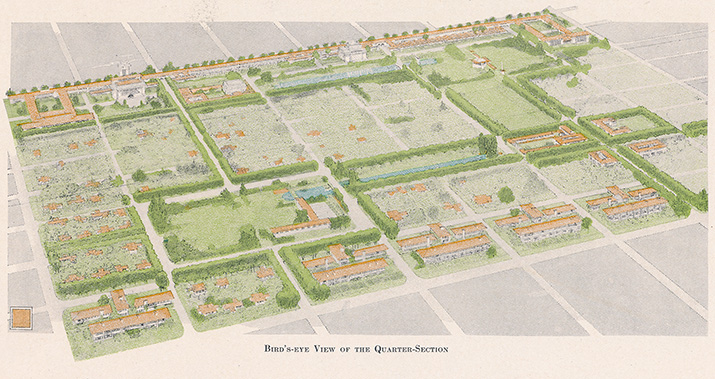
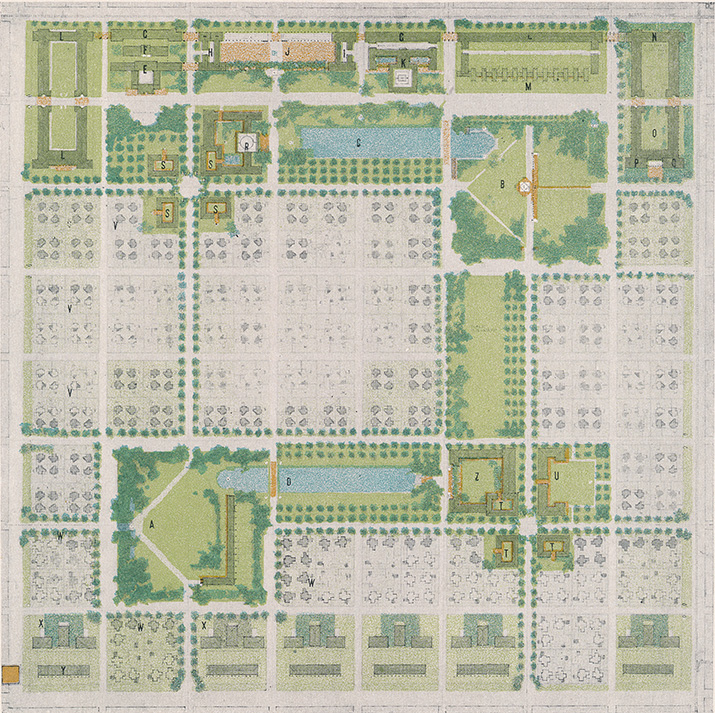
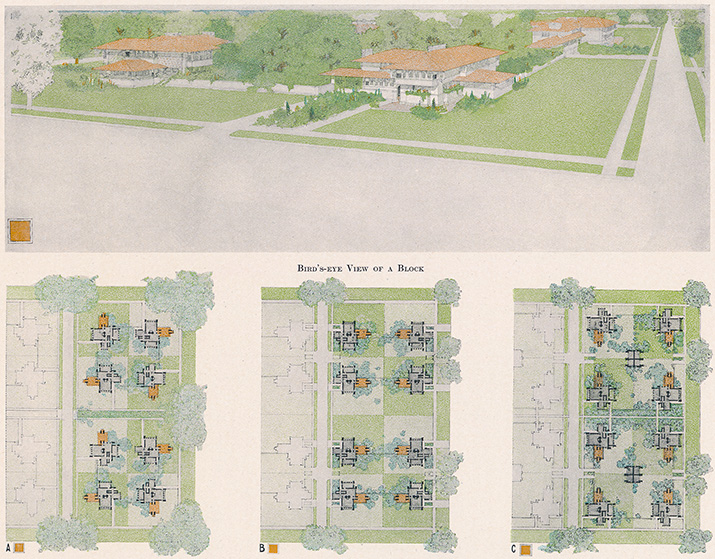
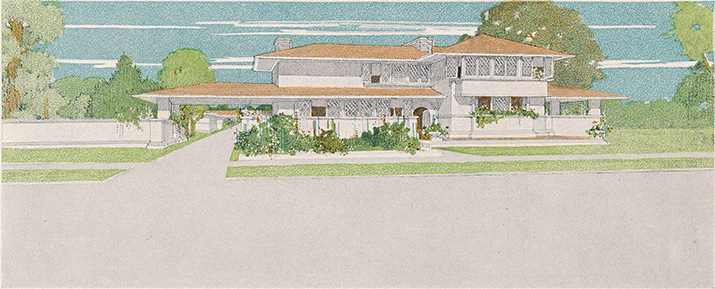
Date: 1923 Title: Successful Houses and How to Build Them (First published in September, 1912 by The MacMillan Company, New York)
Author: White, Charles E. Jr.
Description: First published in 1912. Charles E. White, Jr. was an architect in Chicago, and worked in Wright’s Oak Park studio from 1903 to 1905. White, along with Vernon S. Watson worked with Wright on the River Forest Tennis Club (1906 - S.119). The Walter Gerts Residence was designed by White and built in 1905. Wright remodeled it in 1911 (1911 - S.177). In this volume, many of Wright’s home were included, but only a few were identified.
Images of Wright’s homes included: Moore Residence (First), p.8 (1895 - S.034); Dana-Thomas, pp.41, 51 (Int), 216 (1902 - S.072); Hills, pp.66 (2), 424 (1900 - S.051); Heurtley, p.217 (1902 - S.074); Beachy, p.220 (1906 - S.117); Winslow p.225 (1894 - S.024); Winslow Stable, p.498 (1894 - S.025); Coonley, p.284 (1907 - S.135); Roberts interior, p.350 (1908 S.150); Martin interior, p.397 (1904 - S.100).
These images document the homes prior to 1912. White also wrote The Bungalow Book. (Second Edition)Size: 5.5 x 7.6
Pages: Pp 520
S#: 0156.06.1009
Date: 1923
Title: The Bungalow Book (Hard Cover) (The MacMillan Company, New York)
Author: White, Charles E. Jr.
Description: "Shortly after "'Successful Houses and How to Built Them" was published (1912), requests began to come from readers to the Author for a book specializing on the planning and construction of bungalows..." Charles E. White, Jr. was an architect in Chicago, and worked in Wright's Oak Park studio from 1903 to 1905. White, along with Vernon S. Watson worked with Wright on the River Forest Tennis Club (S.119). The Walter Gerts Residence was designed by White and built in 1905. Wright remodeled it in 1911 (S.177). Of the eight plates in this volume, one is a Frank Lloyd Wright home. Caption: "Bungalow of Middle-Western Type with Partial Second Story. Frank Lloyd Wright, Architect." Tomak Residence, Riverside, Illinois, p.84 (1904 - S.128). (First Edition)
Size: 5.5 x 8.25
Pages: Pp 221
S#: 0156.54.0317Date: 1926
Title: Hollandische Architektur (Dutch Architecture) (Hard Cover) (Published by Albert Langen Verlag [Publisher], Munchen [Munich]. Bauhausbucher 10 [Bauhaus Books Series, No. 10])
Author: J. J. P. Oud
Description: Published in German. Chapter 3 (of 3): Der Einfluss von Frank Lloyd Wright Auf Die Architektur Europas. (The Influence of Frank Lloyd Wright on the Architecture of Europe.)
Translation: Although I am convinced of the inadequacy of any value judgment in art, especially when it refers to contemporaries or people very close to us, the figure of Frank Lloyd Wright stands out so clearly above his surroundings that I can confidently call him one of the greatest of our time, without fearing that a later generation will have to reject this judgment.
His work stood out as such a perfectly rounded whole amidst the architectural creations that, in their lack of style, would come to be known as the style of the 19th century; such unity of conception prevailed in the overall design as well as in the details, and his work was so precise in its expression and so clearly defined in its developmental trajectory that almost no other comparable example can be found.
Does it belong to this era that even the work of the greatest almost always still reveals the process of its creation, while with Wright, everything appears effortless, without any noticeable intellectual strain of production? While I admire others for the talent with which they master their material, I revere Wright because the creative process behind his work remains completely alien and utterly mysterious to me.
This admiration, which has proven itself to be of a high degree in the changing phases of my own development, is not diminished if I do not unconditionally describe Wright's influence on European architecture, which is important, even significant, as entirely positive.
Boards are covered in a yellow cloth. Cover texed is stamped on the cover and printed in red. Aquired from a bookseller in the Netherlands. (First Edition) (Sweeney 175)
Size: 7.25 x 9.25Pages: Pp 77-83
S#: 0175.00.1125
Title Page Spread
Chapter Title
Pp 77-83Date: 1928 Title: New Dimensions: The Decorative Arts of Today in Words & Pictures (Published by Payson & Clarke LTD, New York) (Hard Cover)
Author: Frankl, Paul T.
Description: Dedicated "To a Great American Architect and Creative Artist Frank Lloyd Wright." Forward by Frank Lloyd Wright. Includes 80 pages of text and 124 images, of which three relate to Wright. Original cover price possibly $6.00. (First Edition) (Sweeney 200)
Size: 9.25 x 12.25
Pages: Pp 168
S#: 0200.00.0407
Date: 1928 Title: Cyclopedia of Drawing, Volume I (Leather Bound Stiff Cover) (Published by American Technical Society, Chicago)
Author: American Technical Society
Description: Volume 1 from a four volume set. First published in 1905. Frontispiece: Illustration of "Unity Church, Oak Park, Illinois." Unity Temple was designed by Frank Lloyd Wright in 1904. Text: "Kenilworth Avenue Facade of Unity Church, Oak Park, Illinois. Frank Lloyd Wright, Architect, Chicago Entirely of concrete. Cost, $40,000. Only flat roofs are used in the structure - an unusual treatment for a church." (Fifth Edition)
Size: 5.5 x 8.25
Pages: P 1
S#: 0187.01.0504
Date: 1928 Title: Cyclopedia of Drawing, Volume III (Leather Bound Stiff Cover) (Published by American Technical Society, Chicago)
Author: American Technical Society
Description: Volume III from a four volume set. First published in 1905. Page 72 includes and illustration of the Living Room and floor plan of H.J. Ullman House, Oak Park. Frank Lloyd Wright designed the Ullman Residence in 1904. Text: Design for Living Room in Residence of Mr. H. J. Ullman, Oak Park, Ill. Frank Lloyd Wright, Architect, Oak Park, Ill."
In 1907 this illustration was published in Fourth Exhibition to Be Held in the Carnegie Institute Galleries November, 1907. It was also published in the January 1908 issue of Inland Architect. In 1910, Wright published Ausgefuhrte Bauten und Entwurfe von Frank Lloyd Wright. Plate XVI (16) included a perspective view of the Ullman house, and the tissue overlay included the ground plan and plans for the second floor.
In the January 1928 issue of Architectural Record, Wright included a perspective, ground and second floor plan of the Ullman Residence, p.55. See additional information about the Ullman Residence...
The Ullman Residence remained a project. (Fifth Edition)Size: 5.5 x 8.25
Pages: Pp 72
S#: 0187.02.0504
Date: 1930 Title: Revolt in the Arts (Hard Cover) (Published by Brentano's, New York)
Author: Wright, Frank Lloyd
Description: Architecture - "In Between". Chapter by Frank Lloyd Wright, (First Edition)
Size:
Pages: Pp 123-4, 322, 327-9
S#: 0228.01.1101
Date: 1934
Hard Cover Title: Modern Art: The Men, the Movement, the Meaning (Hard Cover - DJ) (Published by Simon and Schuster, New York)
Author: Craven, Thomas
Description: Chapter 14: An American Architect. In the words of Frank Lloyd Wright, "The artist is always a pioneer, and America cannot afford to believe that great art, as her interpreter, is moribund." The pioneer spirit of America, driven suddenly from its conquest of the land into industrialism, finds expression today, at the pinnacle of its recklessness, in architecture. Its bold and youthful disregard of consequence is embodied in stripped forms of towering steel. Say what you Craven, Thomas will of this architecture and it is fashionable now to condemn it -- words can only weave a superficial garland round the fact of its existence. There it is; and the truth remains that the architect, more than any other artist, has participated in modern American civilization.
Unlike the affiliated arts of sculpture and painting, the architecture of our industrial epoch is a direct reflection of social impulses, an automatic outcome of ways of living. It flaunts no assumptions about life it is the child of life. Its highest values are those of pure function; it is simply a frame for human activity. Whatever reservations the architect may hold individually. his work, if successful, is acquiescent..." Includes two illustrations, Larkin building and St. Marks. (First Edition) (Sweeney 371)Size: 7 x 9.5
Pages: Pp 273-289
S#: 0371.00.0401
Left: Larkin Building
Right: St. MarksDate: 1934
Hard Cover
Title: Modern Art: The Men, the Movement, the Meaning (Hard Cover DJ) (Published by Simon and Schuster, New York)
Author: Craven, Thomas
Description: Second Version: This version appears to also be a first edition (see S.0371.00.0401). The only changes appear to be the dust jacket and the covers. There do not appear to be any other changes.
Chapter 14: An American Architect. In the words of Frank Lloyd Wright, "The artist is always a pioneer, and America cannot afford to believe that great art, as her interpreter, is moribund." The pioneer spirit of America, driven suddenly from its conquest of the land into industrialism, finds expression today, at the pinnacle of its recklessness, in architecture. Its bold and youthful disregard of consequence is embodied in stripped forms of towering steel. Say what you will of this architecture and it is fashionable now to condemn it – words can only weave a superficial garland round the fact of its existence. There it is; and the truth remains that the architect, more than any other artist, has participated in modern American civilization.
Unlike the affiliated arts of sculpture and painting, the architecture of our industrial epoch is a direct reflection of social impulses, an automatic outcome of ways of living. It flaunts no assumptions about life it is the child of life. Its highest values are those of pure function; it is simply a frame for human activity. Whatever reservations the architect may hold individually. his work, if successful, is acquiescent...
Includes two illustrations, Larkin building and St. Marks. (First Edition) (Sweeney 371)
Size: 7 x 9.5
Pages: Pp 273-289
S#: 0371.00.0125Date: 1935 Title: Art In America (Hard Cover) (Published by Reynal & Hitchcock, New York)
Author: Hitchcock, Henry Russell Jr
Description: Chapter VI. III. Wright and the International Style (Third Edition)
Size:
Pages: Pp 128-130
S#: 0377.01.0401
Date: 1936 Title: Understanding Modern Art (Hard Cover) (Published by The Delphian Society)
Author: Katz, Leo; Webster, James Carson
Description: Chapter on Wright. Chapter LIII. Frank Lloyd Wright and the International Style. (First Edition)
Size:
Pages: Pp 775 - 788
S#: 0404.01.0403
Date: 1937 Title: Modern Building, Its Nature, Problems, and Forms (Hard Cover) (Published by Harcourt, Brace and Company, New York)
Author: Behrendt, Walter Curt
Description: Behrendt was a German-American architect and editor of Die Form. He was a friend of Lewis Mumford. Includes many references to Frank Lloyd Wright. Wright said one of his German critics, "is the first architect to whom the atmosphere is more than mere background to his work. He uses it, he calculates with it, again and again he tries to relate his work so finely with the atmosphere that both must seem indissolubly connected..." Photographs related to Wright include the Roberts House, Coonley House, Taliesin (2). (First Edition)
Size: 6 x 9.5
Pages: Pp 241
S#: 0429.28.1115
Date: 1938 Title: The 1940 Book of Small Houses (Hard Cover - DJ) (Published by Simon and Schuster, Inc., New York)
Author: By Editors of Arch Forum
Description: "Frank Lloyd Wright, Architect, Houses for $5,000-$6,000 Income, To the Blackbourns" (Fourth Edition, Related article: Life Magazine - Sept 1938. Original HC List Price $1.96.
Size:
Pages: Pp 141-5
S#: 0430.01.0201
Date: 1939
Title: A Goodly Fellowship (Hard Cover DJ) (Published in November by The MacMillan Company, New York, Boston, Chicago, Dallas, Atlanta, San Francisco)
Author: Chase, Mary Ellen
Description: Chapter 5. "The Hillside Home School". Pp 85-121. Describes the school run by Frank Lloyd Wright's aunts. "...In 1903 this was connected with an adequate and beautiful school building of native limestone, designed and erected by Frank Lloyd Wright, the son of Anna Lloyd-Jones and the nephew of Ellen and Jane. These buildings were built or appropriated in the early years of the school as the need arose. By the time ten years had passed, this healthful and lovely valley in Wisconsin have become known throughout the Middle West and further away not only as a place where children were sure to be well and to receive the best of training, But also as a home where under reasonable discipline and supervision both boys and girls might realize the best of which they were capable in physical and mental, emotional and spiritual growth... We traveled much in the realms of gold at Hillside, so many goodly sights of the earth, entered into many goodly kingdoms of the mind. We were watchers of the skyies there. Whatever visions or imagination I have been able to give to my teaching in the years since then, I owe to two women in a Wisconsin Valley thirty years ago; and I can only wish in all humility that any words of mine may prolong, if but for a season, their rightful immortality." Original list price $2.50. Two copies. (First and Second Edition) (Sweeney 461)
Size: 5.5 x 8.25
Pages: Pp 305
S#: 0461.00.0306, 0461.00.0219Date: 1940
Title: New Directions In Prose & Poetry (Hard Cover) (Published annually by New Directions, Norfolk, Connecticut)
Author: Wright, Frank Lloyd; Section IV Edited by Kaufmann, Edgar Jr.
Description: Section IV: New Directions in Design. I: "The New Design and Public Acceptance." Includes references to Wright. "...The most important contribution our design world has made (expressed in architecture and writing on it) is that of Frank Lloyd Wright; an organic concept based as much on inspiration as on experience. He emphasizes function and material as did the Bauhaus and adds, as their equivalents, the user and the environment. It would be hard to overestimate the fundamental changes which the inclusion of these two basic factors indicates..."
Section IV: II: "Excerpt From London Lectures." In May, 1939, Frank Lloyd Wright lectured at the Royal Institute of British Architects during his visit to England, as holder of the Sir George Watson chair of the Sulgrave Manor Board. These were published in "An Organic Architecture: The Architecture of Democracy," Wright, 1939. "In the meantime, what great creative work have we to show as an actual working basis for the life which we have led or as proof of its validity? Not much. No, it was truly an escapist life we have led. We will find there in that life just application of the word "'escapist" if the word has any meaning at all...
Section IV: III: "Taliesin West is the Arizona home of Mr. And Mrs. Frank Lloyd Wright and the Taliesin Fellowship. The base is large blocks of stone dumped, with cement, into forms. On this is erected a framework of rough stained red wood which supports roof and sides of double canvas flaps. It is one of the clearest of Mr. Wright's poetic accomplishments." Includes five photographs of Taliesin West.
Size: 6.25 x 8.25
Pages: Pp 257-278
S#: 0502.01.0317Date: 1942 Title: The Wisconsin: River of a Thousand Isles (Published by Farrar & Rinehart Inc., New York, Toronto)
Author: Derleth, August
Description: "The Shining Brow." Section VII, Chapter 7. "If I were suffered to apply the word genius to only one living American, I would save it for Frank Lloyd Wright. So said Alexander Woollcott a decade ago, and since Woollcott is not overly given to superlatives, the owner of Taliesin on the shores of the Wisconsin just below Tower Hill, across the river from Spring Green, had every right to be proud of that accolade. This kind of adulation was sweet wine for a man who had for decades endured the gall of being jeered and hooted at for his revolutionary ideas, a man whose architectural concepts were far in advance of their time." (First Edition) (Sweeney 572)
Size: 5.5 x 8.25
Pages: Pp 301-308
S#: 0572.00.1112
Date: 1985 Title: The Wisconsin: River of a Thousand Isles (Soft Cover) (Published by The University of Wisconsin Press, A North Coast Book)
Author: Derleth, August
Description: First published in 1942. "The Shining Brow". Section VII, Chapter 7. "If I were suffered to apply the word genius to only one living American, I would save it for Frank Lloyd Wright." So said Alexander Woollcott a decade ago, and since Woollcott is not overly given to superlatives, the owner of Taliesin on the shores of the Wisconsin just below Tower Hill, across the river from Spring Green, had every right to be proud of that accolade. This kind of adulation was sweet wine for a man who had for decades endured the gall of being jeered and hooted at for his revolutionary ideas, a man whose architectural concepts were far in advance of their time. Also includes a chapter "The Prophet Jenkin" (p. 286-289), concerning Wright's Uncle, Jenkin Lloyd Jones founder of the Abraham Lincoln Center. (Third Edition) (Sweeney 572)
Size: 5.4 x 8.5
Pages: Pp 301-308
ST#: 0572.03.1212
Date: 1995 Title: Geniuses of the Mighty Wisconsin River. Zona Gale, August Derleth, Frank Lloyd Wright. (Published by the August Derleth Society)
Author: Price, Kay
Description: Wright wrote, "I occasionally drove up the river to Portage... to see Zona... While in Japan I read "'Lulu Bett." Straightway I made up my mind to know Zona gale better when I got home... Of course, I hated her environment as utterly unworthy of her (she was an exquisite thing, Wisconsin's Zona Gale.) I hadn't met Olgivanna and I thought Taliesin would be a much more appropriate place for the author of "'Lulu Bett." ...But she was always glad to see us, asking me to come, although she said she valued her Regency at the University of Wisconsin too much ever to be seen with me in public..." "An Autobiography", 1943. (First Edition)
Size: 16 x 11.5
ST#: 1995.65.0713
Date: 1944 Title: Forty-Seven Wisconsin Stories (Self published. Distributed by Chippewa Falls Book Agency, Chippewa Falls, Wisconsin)
Author: Muggah, Mary Gates; Raihle, Paul H.
Description: Chapter 38: Frank Lloyd Wright. The chapter revolves around the earthquake that destroyed Tokyo in 1923, but not the Imperial Hotel... "While everyone deplores the bombing of the beautiful cities of Europe, Wright looks upon it as almost a blessing in disguise. He says that when the war is over, his plan for Broadacre will go to Europe. He hopes that his plans will help to build a better, more beautiful world to live in." Original list price, fourth edition, $2.00.
Size: 5.5 x 8.75.
Pages: Pp 125-127
S#: 0596.01.1013
Date: 1945 Title: Tomorrow’s House (Hard Cover) (Published by Simon and Schuster, New York)
Author: Nelson, George; Wright, Henry
Description: Original HC List Price $3.00. Text & Photos (First Edition)
Size:
Pages: Pp 208-213
S#: 0624.01.0401
Date: 1946 Title: Faces of Destiny (Hard Cover) (Published simultaneously by Ziff-Davis Publishing Co, Chicago, New York and George G. Harrap Co. LTD., London)
Author: Karsh, Yousuf
Description: Short Biography and portrait of Frank Lloyd Wright (Second Edition)
Size:
Pages: Pp 158-9
S#: 0648.01.1101
Date: 1946
Title: If You Want To Build A House (Hard Cover) (Published by The Museum of Modern Art, New York)
Author: Mock, Elizabeth B.
Description: "If you are going to take the trouble to built..." Although not mentioned in the body of the text, there are many photographs and captions of FLW homes Including 1) Goetsh-Winkler (3); 2) Willey (2); 3) Rosenbaum (1); 4) Hanna (2); 5) Fallingwater (4); 6) Taliesin West (1); 7) Pew (1); 8) Pauson (2); 9) La Minitura (1). Seventeen photographs of Wright homes. Thirty-One Thousand Copies Printed. (First Edition)
Size: 7.5 x 10.25
Pages: Pp 96
S#: 0685.21.0318Date: 1947
Title: Mies Van Der Rohe (Stiff Soft Cover) (Published by The Museum of Modern Art, New York. Twelve thousand copies of this book were printed in September 1947 for the trustees of The Museum of Modern Art by the Plantin Press, New York.)
Author: Johnson, Philip C.
Description: Preface. This monograph is published on the occasion of an exhibition of the architecture of Mies van der Rohe held at The Museum of Modern Art, September 16 -- November 23, 1947. "Writings by Mies Van Der Rohe. 1940: Frank Lloyd Wright. An appreciation written for the unpublished catalog of the Frank Lloyd Wright exhibition held at The Museum of Modern Art. About the beginning of this century the great European artistic restoration instigated by William Morris, having grown over-refined, gradually begin to lose force. Distinct signs of exhaustion became manifest. The attempt to revival architecture from the point of view of form appeared to be doomed... At this moment, so critical for us, the exhibition of the work of Frank Lloyd Wright came to Berlin. This comprehensive display and the exhaustive publication of his works enabled us to become really acquainted with the achievements of this architect. The encounter was destined to prove of great significance to the European development... In his undiminishing power he resembled a giant tree in a wide landscape, which, year after year, attains a more noble crown." (First Edition) (Sweeney 686)
Size: 7.5 x 10
Pages: Pp 195-196
S#: 0686.00.0718Date: 1949
Title: Building For Modern Man. A Symposium. (Hard Cover) (Published by Princeton University Press, Princeton, New Jersey)
Author: Edited by Thomas H. Creighton
1) Creighton, Thomas H.
2) Wright, Frank Lloyd Wright 3) Moses, Robert 4) Frank Lloyd Wright
Description: Preface: "In the spring of 1947 some sixty persons whose lives are devoted to the study of man's physical environment were invited to Princeton University to engage in a two-day Conference. The official occasion was Conference Five of Series Two of the academic conferences that marked Princeton's Bicentennial Celebration. The result was a gathering of architects and planners, those who teach architecture and planning, those who write about such subjects, and a sprinkling of those who are engaged in related design fields. Twenty-four prepared papers were read, and in the eight sessions of the Conference a number of extemporaneous rebuttals, refutations, concurrences, and variations were added to the discussion..."
Section VII: Inspiration and Pragmatism
1) "Introduction. The papers in this section of the book may seem out of character with the others that have preceded them. However, this is a symposium, and many points of view are represented. Frank Lloyd Wright and Robert Moses have contributed interesting statements of position - in places brilliant, in each case containing some opinions which are certain to be antagonistic to any point of view the reader may hold.
The final session of the Princeton Conference was a dinner, at which the principal speakers were Wright and Moses..."
2) "Education, Individualism, and Architecture. My favorite university is Princeton. Memory of pleasant times here long ago while delivering the Kahn lectures brings me now from Arizona desert to anticipated Princetonian revels of intellectual fellowship. I have the same nostalgic love for Princeton as for the great founders of our Republic. And yet, I believe, were all education above the high school level suspended for ten years humanity would get a better chance to be what humanitarian Princeton itself could wish it to be. Our thinking throughout the educational fabric has been so far departmentalized, overstandardized, and so split that like a man facing a brick wall counting bricks, we mistake the counting for reality - and so lose or ignore the perspective that would show us the nature and wherefore of the wall as a wall..."
3) "Public and Private Initiative. You have asked me to speak in the role of a public official on public and private cooperation to improve man's physical environment. I appear on this occasion as a timid, inhibited representative of the Philistine or lowest common denominator. My distinguished contemporary, Frank Lloyd Wright, on the other hand, enjoys all the privileges and immunities of an individualist responsible only to his conscience and his God. In such a debate - if debate it is - all the advantages are manifestly with the Sage of Taliesin and Paradise Valley..."
4) "The Mole and the Skylark. For at least fifty- three years of actual practice I have worked away at this affair of planning man's physical environment, meantime believing that only as the integrity of a noble spirit was reflected by it - even projected in it - could a free people have a civilization worthy the Democratic ideal of Freedom.
A witty Frenchman whose name I should remember - I have quoted him so often - said ours is "the only great nation to have proceeded directly from barbarism to degeneracy with no civilization of our own in between." Lifelong I have been trying to do something about that missing civilization - something that would invalidate the witty Frenchman's thrust.
A friendly little note reached me while in Arizona from Moses the Mole (from somewhere in South America..." Original list price $3.50.
Size: 5.5 x 5.6
Pages: Pp 179-202
S#: 0798.43.1023Date: 1951 Title: Elements of Interior Design and Decoration (Hard Cover - DJ) (Published by J.B. Lippincott Company, Chicago, Philadelphia, New York)
Author: Whiton, Sherrill
Description: Influences of Wright and Sullivan. Includes references on Wright and one photograph of the living room at Taliesin by Stoller. Original HC List Price $7.50. (First Edition)
Size:
Pages: Pp 335,386-8
S#: 0834.01.0201
Date: 1952 Title: Built in USA: Post war Architecture (Hard Cover) (Published by The Museum of Modern Art, Distributed by Simon & Schuster, New York)
Author: Hitchcock, Henry-Russell & Drexler, Arthur
Description: Three Chapters on Frank Lloyd Wright (First Edition)
Size:
Pages: Pp 1-2, 17, 27-30,114-123
S#: 0869.01.1201
Date: 1952 Title: Dynamic Dissonance in Nature and the Arts. Pablo Picasso, Frank Lloyd Wright, James Joyce, Henry Moore, Ezra Pound, Arnold Schoenberg. (Hard Cover - DJ) (Published by Farrar, Straus and Young, Inc., New York. Designed by Merle Armitage in 1952 and printed by the Hallmark-Hubner Press, New York.)
Author: Danz, Louis
Description: "This is one of the most revolutionary books on aesthetics to appear in a hundred years, a book of sharp and deep observations to rebuke the pallid "'art criticism" of our day. It is certain to create a storm..." (dust jacket). "We seek such a man. We seek the architect who gives us everything the machine age can and besides gives us the richness life has to offer. We seek a man who is sunlight and climate, landscape and soil, color and texture, a man who lives his architecture, a man who abhors the false, who will not accept decadence, imitation or duplication... Who is he? We might call him Emerson or Longfellow, Stephan foster or Thoreau. And certainly there is in him much of Walt Whitman... for he is aesthetically an architectural summation of our entire era. This man is Frank Lloyd Wright, an architect who can sing and curse, love and despise, who is both tender and brutal, capable of fiery passion and withering disdain." Original list price $5.00.
Size: 6.25 x 9.5
Pages: Pp 261
S#: 0910.25.1213
Date: 1952 Title: Roots of Contemporary American Architecture (Hard Cover - DJ) (Published by Reinhold Publishing Corp., New York)
Author: Mumford, Lewis; Wright, Frank Lloyd
Description: 1) Ch. 16: "Nature as Architecture, The Bad Lands." Reprinted from Frank Lloyd Wright on Architecture, 1941, pages 191-199. 2) Ch. 20: "The Art and Craft of the Machine." Reprinted from Modern Architecture, 1931, pages 7-23. Originally delivered at Hull House, Chicago, in 1901. 3) Biographical Sketches: Frank Lloyd Wright. Original HC List Price $7.00. (First Edition)
Size:
Pages: Pp 132-140, 169-185, 435-6
S#: 0869.03.0804
Date: 1972 Title: Roots of Contemporary American Architecture. 37 Essays from the Mid-Century to the Present (Published by Dover Publications, Inc., New York)
Author: Collected and Edited By: Mumford, Lewis
Description: First published in 1952 by Reinhold publishing. This Dover edition replaced the original "Prefatory Note" with the "Preface to the Second Edition" which was published in 1959 by Grove Press, Inc. 1) Ch. 16: "Nature as Architecture, The Bad Lands." Reprinted from Frank Lloyd Wright on Architecture, 1941, pages 191-199. 2) Ch. 20: "The Art and Craft of the Machine." Reprinted from Modern Architecture, 1931, pages 7-23. Originally delivered at Hull House, Chicago, in 1901. 3) Biographical Sketches: Frank Lloyd Wright. Original list price $6.00. (First Dover Edition)
Size: 5.25 x 8.4
Pages: Pp Cover, 132-140, 169-185, 435-437
S#: 1909.10.0810
Date: 1953
Title: 7 Arts (Soft Cover) (Published by Permabooks, a division of Doubleday & Company, Inc. Garden City, New York) Selected and edited by Fernando Puma
Author: Wright, Frank Lloyd
Description: A compilation of published in relationship to the arts and includes a reprint of Frank Lloyd Wright's "Organic Architecture" originally published in Architectural Record, May, 1952. "The principles of Frank Lloyd Wright's "organic architecture" we're actually written in 1894. They were first published an article by Wright in Architectural Record, March 1908, and are republished here, along with his current article. His credo, dated 1894 but difficult to improve upon today, is important background for his criticism of the contemporary architectural scene." That "credo" is reprinted along the top of the pages of the article. The new article "Organic Architecture Looks at Modern Architecture" appears along the bottom two-thirds of the pages. Includes a photograph of Fallingwater and an illustration of the Guggenheim. Original cover price 50c. (Sweeney 909)
Size: 4.25 x 7.1
Pages: Pp 64-74
S#: 0909.01.1017Date: 1954 Title: Homes of the Brave (Hard Cover DJ) (Published by Alfred A. Knopf, Inc., New York)
Author: Robsjohn-Gibbings, T.H.
Description: Chapter 2: "Organic Architecture, Frank Lloyd Wright. ...It is incorrect to assume - as some of Wright's disciples do - that the American art of living began with Wright... Of all who contribute to the new house during the nineteenth century, three men were outstanding. They were Horatio Greenough, Louis Sullivan, and Frank Lloyd Wright... To people living in an age of abundance, Wright's conception seemed at first to offer less... People, land, and building, separated for centuries by an architecture totally preoccupied with academic style, were reunited once again." Wright mentioned throughout the rest of the book. Author of "Good-bye, Mr. Chippendale", 1944. "This very funny book is fundamentally a serious criticism of American (and imported) interior decoration and exterior architecture for the past sixty years." (Dust jacket.) Includes two illustrations, the first is of the Thomas Gale house (1904 - S.098). Drawings by Mary Petty. Original list price $3.50. (First Edition)
Size: 6.26 x 9.5
Pages: Pp 7-16
S#: 0990.00.0112
Date: 1955
Title: Architecture, Ambition and Americans. A history of American architecture, from the beginning to the present, telling the story of the outstanding buildings, the men who designed them and the people for whom they were built. (Hard Cover) (Published by Harper & Brothers, New York)
Author: Andrews, Wayne
Description: Firsts published in 1947. Andrews published many articles in the 1940-50s. Harper's Bazaar - July 1948; Saturday Review - November 14, 1953; Perspectives USA No. 4 - Summer 1953. Chapter 6, H: The Chicago Story. "Young Frank Lloyd Wright. Wright is credited, even by his enemies, with being the greatest architect of the twentieth century. He is the greatest artist to emerge from the Middle West, the only one who may be said to have conquered Chicago. One reason for his success is that he had always known what he wanted. "'You've got to have guts to be an architect!" he has said. "'People will come to you and tell you what they want, and you will have to give them what they need..." " 17 illustrations and photographs by Wayne Andrews include: Coonley (2); Bradley (1); Lloyd Lewis (1); Taliesin (1); Fallingwater (2); Johnson Wax Co. (2); V. C. Morris (2); Florida Southern College (1); Unitarian Meeting House (2); Taliesin West (3). (Fifth Edition)
Size: 6 x 9.5
Pages: Pp 315
S#: 1092.95.0816Date: 1957
Title: The Shingle Style, Architectural Theory and Design from Richardson to the Origins of Wright (Hard Cover DJ) (Published by Yale University Press, New Haven and London)
Author: Scully, Vincent J.
Description: First published in 1955. This third edition published in 1957. Many references to Frank Lloyd Wright including the last chapter on Wright's early career. Dust jacket: "The Colonial Revival of the 1870s was inspired by a longing for the earlier for the early American past, a nostalgia not present before in this century. This is the closest study yet made of all the complex inspirations and cultural influences that were fused in the shingle style of wooden suburban and resort buildings of the period... from H. H. Richardson's early work to Frank Lloyd Wright's first house in Oak Park, a precursor of much of the modern architecture of the 20th century..." Chapter 9: "The last section of the book, on the origins in early development of Frank Lloyd Wright, is one of Scully's best. This chapter shows a mature understanding and a just handling of the academic tradition and of the early work of one of America's greatest architects." (The Art Bulletin.) Includes six photographs and illustrations relating to Wright's work, and one photograph on the cover. Original hard cover list price $7.50. (Third Edition) (Sweeney 1047)
Size: 8 x 10.75
Pages: Pp 181
S#: 1047.03.1021Date: 1976 Title: The Shingle Style and the Stick Style (Soft Cover) (Published by Yale University Press, New Haven and London)
Author: Scully, Vincent J.
Description: First First published in 1955. A revised edition was published in 1971. This edition was published in 1976. Many references to Wright including Chapter nine on Wright's early career. Back cover: "As the definitive study of the complex inspirations and cultural influences that were fused in the Shingle Style of wooden suburban and resort buildings of the period 1872 to 1889, Mr. Scully's book has received much critical acclaim. He presents the published designs in the written statements of the architects, as well as contemporary criticism of the buildings to analyze the development of the shingle style from Richard Simmons early work to Wright's first house in Oak Park... The last section of the book, on the origins in early development of Frank Lloyd Wright, is one of Scully's best. This chapter . . . shows a mature understanding and a just handling of the academic tradition and of the early work of one of America's greatest architects." Original SC List Price $8.95. (Fourth Edition) (Sweeney 1047)
Size: 7 x 10
Pages: Pp 184
S#: 1047.04.0501
Date: 1958 Title: Masters of Modern Architecture (Hard Cover - DJ) (Published by Bonanza Books, New York)
Author: Peter, John
Description:
Size:
Pages: Pp 21,26, 41-61, 201-2, 222
S#: 1221.01.1201
Date: 1959 Title: Words to Live By (Hard Cover) (Published by Simon and Schuster, Inc. New York)
Author: Wright, Frank Lloyd; Edited By William Nichols
Description: Comprised of over ninety essays previously published in "This Week Magazine" from 1947 to 1959. Wright's essay "Beauty" was published in the January 27, 1957 issue. Each essay is proceeded by a quote or poem. Of interest, is the quote by John Keats proceeding Wright's essay. Wright's essay pages 147-148. Includes 4 x 6 four page descriptive Presentation Card listing Frank Lloyd Wright on the cover, as one of authors. Stamped on back cover: Compliments of Broce Construction Co. "Beauty" was originally an address to the Taliesin Fellowship following a Sunday Breakfast, June 11, 1950. (First Edition)
Size: 6 x 9.1
Pages: Pg 242
S#: 1274.01.0101
Date: 1959 Title: The House Beautiful Treasury of Contemporary American Homes (Hard Cover - DJ) (Published by Hawthorn Books, Inc., New York)
Author: Barry, Joseph
Description: Of the 32 homes featured in this book, nine were designed by Wright. The first three chapters are dedicated to Frank Lloyd Wright. Original HC List Price $12.95. (First Edition)
Size:
Pages: Pp10-21
S#: 1275.02.0402
Date: 1960 Title: A History of Modern Architecture (Published in the U.S. by Frederick A. Praeger, Inc., Publishers, New York)
Author: Joedicke, Jurgen
Description: First published in 1959. Translated from German by James C. Palmes. Chapter three: "Frank Lloyd Wright." Describes Wright's connection with the School of Chicago, the idea of organic, relationship with nature, Wright's early houses, his influence on Europe and Wright's later work. Includes thirteen photographs and two illustrations of Wright's buildings. (Second Edition)
Size: 7.5 x 10.25
Pages: Pp 30-37
S#: 1407.03.0607
Date: 1962 Title: The Intellectual Versus The City. From Thomas Jefferson to Frank Lloyd Wright. (Hard Cover, DJ) (Published by Harvard University Press and The M.I.T. Press, Cambridge, Mass. Copyright by the President and Fellows of Harvard College and the Massachusetts Institute of Technology.)
Author: White, Morton & Lucia
Description: Chapter 12: "Architecture against the City: Frank Lloyd Wright. ...A powerful artist, a dramatic personality and lively writer, he dominates twentieth-century American architecture in a way that makes him an inevitable representative of his discipline in a study like the present one." (First Edition) (Sweeney 1487)
Size: 6.25 x 9.5
Pages: Pp 189-99
S#: 1487.00.1102
Date: 1977 Title: The Intellectual Versus The City. From Thomas Jefferson to Frank Lloyd Wright. (Soft Cover) (Published by Oxford University Press, Oxford, London, New York. First published in 1962 by Harvard University Press and The M.I.T. Press, Cambridge, Mass.)
Author: White, Morton & Lucia
Description: Includes a chapter on Frank Lloyd Wright. Chapter 12: "Architecture against the City: Frank Lloyd Wright. ...A powerful artist, a dramatic personality and lively writer, he dominates twentieth-century American architecture in a way that makes him an inevitable representative of his discipline in a study like the present one." This 1977 includes a new Foreword for 1977. Original list price $3.95. (Third Edition)
Size: 5.25 x 8
Pages: Pp189-99
S#: 1487.01.0412
Date: 1963 Title: Architecture: Nineteenth and Twentieth Centuries (Hard Cover) (First published in 1958. Published by Penguin Books, Baltimore, Maryland) (The Pelican History of Art, Edited by Nikolaus Pevsner)
Author: Hitchcock, Henry-Russell
Description: Chapter 19: "Frank Lloyd Wright and His California Contemporaries". Summarizes Wrights life and work, and touches on Maybeck, Howard, Green and a few other California Architects. Also heavily included in "The Detached House in England and America". Includes eight floor plans including the Heller, Husser, Hickox, Willitts, Glasner, Millard, Willey and Jacobs Residences. Twelve black & white plates include the Winslow (p128a), Hickox (p142a), Willitts (p142b), Ross (p143a), Millard (p144), Fallingwater (p145a) and Friedman (p145b) Residences, River Forest Golf Club (p128b), Unity Temple (p143b), S. C. Johnson (p146a) and the Guggenheim Museum (p188a & b). (Second Edition) (Sweeney 1532)
Size: 7 x 10.5
Pages: Pp 253-279, 320-335
S#: 1532.00.0113
Date: 1963 Title: The Highway and the City (Soft Cover) (A Harvest Book. Published by Hartcourt, Brace & World, Inc., New York)
Author: Mumford, Lewis
Description: A compilation of 23 articles written by Mumford between 1953 and 1963, including two concerning Frank Lloyd Wright. 1) "What Wright Hath Wrought", published in the New Yorker, December 5, 1959, "The Skyline: What Wright Hath Wrought" (S.1339). 2) "Postscript: In Memoriam: 1869-1959", published in The Proceedings of the American Academy of Arts and Letters and the National Institute of Arts and Letters as "Frank Lloyd Wright", 1960. "One of our great redwoods has fallen and left a space we cannot fill by any quick plantation of lesser trees... By general agreement today, he counts as one of the greatest creative artist the nineteenth century brought forth in any field... It took three centuries to grown this man, and it may take an even longer time to plumb the depths of his genius and to follow through to their ultimate destinations all the trails he opened up." Original list price $1.65. (First Edition) (Sweeney 1533)
Size: 4.25 x 7.1
Pages: Pp 124-142
S#: 1533.00.0113
Date: 1964 Title: L'Architechture Du XX Siecle (The Architecture of the Twentieth Century) (Hard Cover) (Published by Julliard, Paris. Printed in Switzerland)
Author: Bernier, Georges and Rosamond
Description: Printed in French. "This book prepared under the direction of Monique Schneider-Maunoury. The texts and illustrations in this book have been selected from L'Oeil Magazine of Art, Architecture and Decoration, directed by Georges and Rosamond Bernier. Chapter 5: Frank Lloyd Wright, Pp 48-59. 18 photographs and illustrations include: SC Johnson, Robie, Imperial Hotel, Fallingwater, Taliesin West, Taliesin, Unitarian Meeting House, Pauson, Florida Southern College (2), David Wright (2), Mile High Building, Dallas Theater (2), Guggenheim (3). (First Edition)
Size: 9.5 x 12.5
Pages: Pp 282
S#: 1596.27.0314
Date: 1966 Title: Men of Modern Architecture (Hard Cover - DJ) (Published by Macrae Smith Company Philadelphia)
Author: Forsee, Aylesa
Description: Chapter Two: Frank Lloyd Wright: Uncommon Architect, Uncommon Man. Original HC List Price $4.75 (Second Edition)
Size:
Pages: Pp 35-64
S#: 1652.01.0102
Date: 1967 Title: Sources of Modern Architecture, A Bibliography (Published by Lund Humphries, London, for the Architectural Association, London) (An edition was published in New York by George Wittenborn.)
Author: Compiled by: Sharp, Dennis
Description: Includes a section on Frank Lloyd Wright (pages 38-39). "In 1900, as Hitchcock has remarked, "'he came to maturity'. The prairie house period began. People in America were beginning to take notice of his writings, lectures and buildings. During the next decade Europe became aware of the work of this remarkable architect..." It includes a short bibliography and a list of 29 books and articles by and about Wright. (Paper Number 2 of 3.) (First Edition) (Sweeney 1685)
Size: 8.25 x 11.6
Pages: Pp 56
S#: 1685.00.0613
Date: 1967 Title: American Art Since 1900, A Critical History (Soft Cover) (Published by Frederick A. Praeger, New York, Washington)
Author: Rose, Barbara
Description: Includes references on Wright and seven photograph. Original SC List Price $3.95 (Second Edition)
Size:
Pages: Pp 320
S#: 1686.01.0301
Date: 1968 Title: Conversations with Henry Brandon (Hard Cover DJ) (Published by Houghton Mifflin Company, Boston)
Author: Brandon, Henry; Wright Frank Lloyd
Description: Chapter 3: "Frank Lloyd Wright: Beyond Modern Architecture. He was not just a creative genius, he was a visionary with a poetic pathos. Like so many geniuses, he was an eccentric and like so many eccentrics he was egocentric, and because he was so flamboyantly, so rebelliously egocentric he tended to be tyrannical. But, as everything he did, even his tyranny was in the grand manner... November 1957." One of 15 interviews. Original list price $4.95.
Size: 5.6 x 8.75
Pages: Pp 55-62
S#: 1721.00.0613
Date: 1968 Title: Great Modern Architecture (Published by Studio Vista Limited, London and E.P. Dutton and Co., Inc, New York)
Author: Cantacuzino, Sherban
Description: First three chapters in the book pertain to Wright. 1: Unity Temple; 2: Taliesin West; 3: S.C. Johnson and Son Administration Building. Includes 15 photographs and four illustrations. First published in 1966. Original Soft Cover price $1.95. (Second Edition)
Size: 5 x 7.25
Pages: Pp 8 -27
S#: 1732.05.1006
Date: 1968
Title: Architecture in Chicago & Mid-America. A Photographic History (Hard Cover DJ) (Published by Atheneum Publishers, New York)
Author: Andrews, Wayne
Description: Dust jacket: "Here in 260 stunning photographs (all but 31 of which are the work of Mr. Andrews) is a magnificently comprehensive survey of the important buildings of the middle west from the days of the Greek and Gothic Revivals to the present. All of the world-famous Chicago skyscrapers are included, and for the first time the masterpieces of Louis Sullivan, Frank Lloyd Wright, and Eliel and Eero Saarinens in this area are gathered together in one book. But Mr. Andrews has not slighted the great European architects' contribution to the middle west... While and unqualified admirer of Frank Lloyd Wright, Mr. Andrews has done justice to the work of the eclectics who never claimed to be part of the modern movement." Includes two extensive sections on Frank Lloyd Wright: "The Early Work of Frank Lloyd Wright," pages 65-84, and "The Return of Frank Lloyd Wright," pages 120-140. Includes 64 photographs of Wright's work. Original list price $20.00. (First Edition)
Size: 8.5 x 11.1
Pages: Pp 186
S#: 1757.22.0219Date: 1969 Title: Architecture in New York, A Photographic History (Hard Cover DJ) (Published by Atheneum, New York)
Author: Andrews, Wayne
Description: In 255 photographs, magnificently reproduced, the incredible range of the architecture of New York State, from Manhattan Island to Chautauqua County, is surveyed by a connoisseur (dust jacket). Section on Frank Lloyd Wright, pages 147-155. Includes photographs of Darwin D. Martin Residence, Larkin Building (2), Boynton and Davidson Residences, Heath Residences (2), Friedman Residences (2), Guggenheim Museum (3) plus the cover. Original list price $17.50 until Dec. 25, 1969, then $20.00. (First Edition) (Sweeney 1758)
Size: 8.75 x 11.5
Pages: Pp 188
S#: 1758.00.0613
Date: 1971 Title: History of Notable American Houses, The American Heritage (Hard Cover - DJ)
Author: Davidson, Marshall B.
Description: Original HC List Price $19.95. (First Edition)
Size:
Pages: Pp 239 72, 306-10 13 19-24 26 30-31 34 39 46-7 49 50-51 55
S#: 1850.01.0301
Date: 1972
Title: Architects And Man's Skyline (Hard Cover DJ) (Published by Dodd, Mead & Company, New York)
Author: Poole, Gray Johnson
Description: Chapter 7: "Frank Lloyd Wright, 1869-1959. Prolific in prose and in his innovative architectural designs, he had no doubt about his own genius. Childhood toys and architect Louis H. Sullivan were acknowledged by Frank Lloyd Wright as major influences on his work. The playthings, always referred to by Wright as the gifts, or first seen by his schoolteacher mother in the Friedrich Froebel Kindergarten exhibit at the Philadelphia Centennial of 1876..." Dust jacket: "From the beginning of civilization, man has been a builder, and this book tells the storeis of the careers of archiects whose genius and imagination have created buildings that stand as monuments to their times. Men such as Phidias, Brunelleschi, Wren, Wright, Mies van der Rohe, and Doxiadis, who, in changing man's skyline, often built his dream, have left their imprint upon the world in which they lived. Their creations of temples, palace, theatres, fortresses, homes, offices, and memorials constitute an eloquent transcription of the cultures they reflect." Includes one photograph of the Annie Pfeiffer Chapel and a portrait of Wright. Original list price $5.95. (First Edition)
Size: 5.5 x 8.25
Pages: Pp 176
S#: 1909.69.0921Date: 1973
Title: A History of The Modern Movement: Art, Architecture, Design (Soft Cover in Three Volumes) (Published by Van Nostrand Reinhold Company, New York; Looking and Seeing, London)
Author: Rowland, Kurt
Description: Includes information on Sullivan and Wright. Photographs related to Frank Lloyd Wright's work include: Vol 1: The Winslow, Willits, Martin, Robie and Coonley Houses as well as Unity Temple (p.43-47). Vol 3: Robie (p168) and Westcott House (p.180). Original price stamped inside $3.95 (each). (First Edition)
Size: 8.5 x 10.5
Pages: Pp 240
S#: 1940.18.0716 (1-3)Date: 1973/1982 Title: Historic Architecture in Mississippi (Hard Cover - DJ) (Published by the University Press of Mississippi, Jackson, Mississippi)
Author: Crocker, Mary Wallace
Description: Part Three, Ocean Springs: "Louis Sullivan Cottages (1890 - S.005-006, Charnley 1890 - S.007-008). Who designed the two bungalows and the octagonal cottage located on east beach in Ocean Springs - Louis Sullivan or Frank Lloyd Wright? There will probably never be definitive answer to that question. Sullivan Wrote... Frank Lloyd Wright, however, in is biography of Sullivan entitled "'The Genius and the Mobocracy', wrote "'He remained away for six weeks at Ocean Springs, Mississippi in the country house I had designed for him..." Includes one photograph. (Fourth Edition - 1982) (Sweeney 1911)
Size: 9 x 11.75
Pages: Pp 96-99
S#: 1911.00.1212
Date: 1973
Title: Tesla Speaks (Through Mental Transmission or ESP) (Hard Cover DJ) (Published by Unarius - Science of Life, El Cajon, California)
Author: Norman, Ruth E.; Speagel, V
Description: Dust jacket: "In regard to the manner in which this book Tesla Speaks was written, let it be said that it was not done in the usual manner of planning, effort, trial and error or of writing either with pen or on the typewriter - a thousand or more sheets, then the normal (for the earth man) way of sifting out the comparatively few pages - possibly two hundred or less, of the several thousand that the author later feels adequate to be installed within his book..." Chapter 30 (Pages 291-300). "8/7/73 -- 9:30 p.m. Frank Lloyd Wright Speaks: Good evening to you. My name is Frank Lloyd Wright, and while on your earth plane, I have been known to have developed a technique of architecture which was unique at the time and carried out the feeling of the relationship of a man to his total environment. I have attempted to make it possible for the homeowners to feel the atmosphere of totality -- one in which they could relate their higher selves to the expression that overlies the total environment and which is an expression of the infinite oneness of creation..." (First Edition)
Size: 5.5 x 8.5
Pages: Pp 334
S#: 1940.22.0118Date: 1976
Title: Ladies and Gentlemen, The Garry Moore Show. Behind the Scenes When TV Was New. (Hard Cover DJ) (Published by Stein and Day, New York)
Author: Sanford, Herb; Introduction by Garry Moore
Description: Chapter 13. Frank Lloyd Wright, Rocky Graziano, and More. In the mid-fifties, celebrated architect Frank Lloyd Wright appeared on "Omnibus" and "Adventure." In each case he walked off the set in the middle of the interview. This was puzzling. Both shows were immaculately produced. The host -- Alastair Cook on "Omnibus" and Charles Collingwood on "Adventure" were knowledgeable and charming. But we still wanted to persuade Frank Lloyd Wright to visit the Gary Moore Show... Mr. Wright was wound up. He would have gone on indefinitely but for the inevitable station break that signaled the conclusion of the interview. Marcia was waiting for him backstage. "I led him across the stage behind a drop while Denise was doing a song out front. We nearly didn't make it. Mr. Wright stopped right there, behind the drop, and asked me in a normal speaking voice, not in the stage whisper, who had designed our theater.." Original list price $10. (First Edition)
Size: 6 x 9.25
Pages: Pp 127-132
S#: 2020.37.0618Date: 1978
Title: Magnificent Builders & their Dream Houses (Boxed Slip Cover) (Published by American Heritage Publishing Co., Inc. New York)
Author: Thorndike, Joseph J.
Description: Ch. 3: Frank Lloyd Wright's Taliesins.
To Frank Lloyd Wright, home was more than a place to hang his wide-brimmed hat and his flowing black cape. It was his office, his studio, and his pulpit. It was a standing advertisement of his genius. It was headquarters and dwelling place, not only for his family but also for a devoted band of architectural students, usually numbering from twenty to forty, who came to learn from the master.
Wright built the first of two such homes among the green hills of southern Wisconsin, the land of his birth. The second was built a quarter century later in the harsh, bare desert of Arizona. He named each Taliesin, after a legendary Welsh poet. The first Taliesin was the scene of repeated turmoil in Wright's tempestuous married life-and of one fearful tragedy. Taliesin West was the sunny stage on which he played out with immense enjoyment his role as the greatest architect of America and, as his admirers fervently believed, of the world. When he died there in 1959, a few months short of ninety-two, he stood at the professional peak of a life that had begun only two years after the Civil War...
Includes twelve photographs and illustrations of Taliesin, Taliesin West, Frank Lloyd Wright and the four women in his life. Note: The photograph of Mamah Cheney is the first time we have seen this particular photography published (S#0058.02). Credit for the photograph goes to the Chicago Tribune. Two copies. One with a boxed slip cover and one with dust jacket ($29.95). (First Edition)
Size: 9 x 11.5
Pages: Pp 106-115
ST#: 1978.10.1202Date: 1978
Title: Magnificent Builders & their Dream Houses (Hard Cover DJ) (Published by American Heritage Publishing Co., Inc. New York)
Author: Thorndike, Joseph J.
Description: Ch. 3: Frank Lloyd Wright's Taliesins.
To Frank Lloyd Wright, home was more than a place to hang his wide-brimmed hat and his flowing black cape. It was his office, his studio, and his pulpit. It was a standing advertisement of his genius. It was headquarters and dwelling place, not only for his family but also for a devoted band of architectural students, usually numbering from twenty to forty, who came to learn from the master.
Wright built the first of two such homes among the green hills of southern Wisconsin, the land of his birth. The second was built a quarter century later in the harsh, bare desert of Arizona. He named each Taliesin, after a legendary Welsh poet. The first Taliesin was the scene of repeated turmoil in Wright's tempestuous married life-and of one fearful tragedy. Taliesin West was the sunny stage on which he played out with immense enjoyment his role as the greatest architect of America and, as his admirers fervently believed, of the world. When he died there in 1959, a few months short of ninety-two, he stood at the professional peak of a life that had begun only two years after the Civil War...
Includes twelve photographs and illustrations of Taliesin, Taliesin West, Frank Lloyd Wright and the four women in his life. Note: The photograph of Mamah Cheney is the first time we have seen this particular photography published (S#0058.02). Credit for the photograph goes to the Chicago Tribune. Two copies. One with a boxed slip cover and one with dust jacket ($29.95). (First Edition)
Size: 9 x 11.5
Pages: Pp 106-115
ST#: 1978.68.1222Date: 1978
Title: Theory and Design in the First Machine Age (Soft Cover) (Published by Praeger Publishers, Inc., New York)
Author: Banham, Reyner
Description: First published in 1960 (fifth edition).
Chapter 11: Holland: Berlage and attitudes to Wright. The rapid evolution of de Stijl theory and practice may be largely attributed to the clear-cut polemical situation in which the group's architects found themselves, with their own Rationalist, mechanistic, abstract approach in direct opposition to the fantasticated, handicraft, figurative approach of the Wendingen group in Amsterdam. But, as is so often the case in polemics of this kind, the violent opponents had a great deal in common - in this case the example of H. P. Berlage, and his advocacy of F. Lloyd Wright...
If one sets out those theories in short form--to manipulate space with walls within an order that gives a style proper to an emergent, irreligious society, one sees that this formula is also the one by which Berlage evaluated the work of Frank Lloyd Wright. He came upon Wright's work apparently unprepared in 1911, although the first Wasmuth volume had appeared in the previous year, and he was thus the third significant European theorist to discover Wright for himself. He had been preceded by Professor Kuno Francke, inspirer of the first Wasmuth volume, in 1909; and by C. R.
Ashbee, who wrote the introduction to the second Wasmuth volume, and had visited Wright as early as 1901. The effect of the buildings he saw, and such Wright texts as he seems to have read, must have been to convince him that in Wright he saw a reflection of his own ideals. The sense of repose that he felt in the Martin House, was confirmed by Wright's statement that "Simplicity and repose are the qualities that measure the true value of any work of art"ť and his admiration for Wright's straightforward use of walling by the Wrightian claim that "The Wall was let alone from base to cornice or eaves."ť
As a result, the lecture he gave to the Zurich Ingenieur - und Architektenverein, in March 1912, on his American experiences, pays due tribute to Richardson and Sullivan, but is dominated by Wright...
Chapter 12: De Stijl: the Dutch phase. Discusses Frank L:loyd Wright's use of Cubism. The second essay, Der Einfluss von Frank Lloyd Wright auf die Architektur Europas, seems to have been written partly for this Bauhausbuch, and partly for the Wendingen volume on Wright which appeared in 1925. It does not contain much by way of appreciation of Wright that might not have been written by Berlage, except for some comments on the de luse aspects of Wright's domestic work, to which reference will be made in the next chapter. There is however, an important attempt to sort out the meaning of the Wrightian and painterly contribution to younger Dutch architects" work that sheds light on what 'Cubism'-that is, the art of Mondrian and van Doesburg- meant to him. It proved disappointing, he says, because formalism weakened its impact just at the time when its consequences promised to be of the greatest importance for the future of the art of building. Nevertheless, "Like the influence of Wright, Cubism played an important part in producing the characteristic forms that found expression in the aforementioned current of European architecture (scil. de Stijl)"ť and he was prepared to put a very high valuation on its contribution to the growth of the new architecture of his generation...
Chapter 13: Expressionism: Amsterdam and Berlin. One again, references are made to Frank Lloyd Wright and his work. (Fifth Edition)
Size: 5.5 x 8.25
Pages: Pp 338
ST#: 1978.69.1023Date: 1979
Title: Search For New Art. Root, Wright, Monet, Cezanne, Brady, Griffith (Soft Cover) (Published by Red Wing, Minnesota)
Author: Biederman, Charles
Description: Chapter 14: Pages 77-118, New Vision of Architecture. Extensive chapter includes many references to Frank Lloyd Wright as well as photographs of: Larkin Building, Unity Temple (2), Robie House, Husser Residence, Municipal Boathouse, Bradley and Hickox Residences. (First Edition)
Size: 8.5 x 11
Pages: Pp 145
ST#: 1979.44.0719Date: 1982 Title: The Innovators: 16 Portraits of the Famous and the Infamous (Hard Cover - DJ)
Author: Nash, Jay Robert
Description: Chapter 14: Frank Lloyd Wright, The Grand Architect of the Earth. (First Edition)
Size:
Pages: Pp 240
ST#: 1982.07.0401
Date: 1986 Title: American Buildings and Their Architects, Volume 5. The Impact of European Modernism in the Mid-Twentieth Century (Soft Cover) (Published by Oxford University Press, Oxford, New York, Toronto, Delhi, Bombay, Calcutta, Madras, Karachi, Petaling Jaya, Singapore, Hong Kong, Tokyo, Nairobi, Dar es Salaam, Cape Town, Melbourne, Auckland)
Author: Jordy, William H.
Description: First published 1972. Six chapters. Chapter V: The Encompassing Environment of Free-Form Architecture: Frank Lloyd Wright's Guggenheim Museum. Whatever its faults - and who can unreservedly praise it? - the Solomon R. Guggenheim Museum is a liberating building. It is liberating, first, in the simple sense of being the worthy, unusual scheme that would "'never be built' but was. As such it encourages audacity in the Future." First published in 1972 by Doubleday & Co., Inc, Garden City, New York. First issued in paperback in 1976 by Anchor Books, Garden City, New York. Includes over forty photographs and illustration related to Wright. Original cover price $16.95. 6 x 9.25. Two copies. (Second and Fourth Edition) (Sweeney 1877)
Size: 6 x 9.25
Pages: Pp 279-359
ST#: 1877.02.1010, 1877.04.0612
Date: 1986 Title: American Buildings and Their Architects, Volume 4. Progressive and Academic Ideals at the Turn of the Twentieth Century. (Soft Cover) (Published by Oxford University Press, Oxford, New York, Toronto, Delhi, Bombay, Calcutta, Madras, Karachi, Petaling Jaya, Singapore, Hong Kong, Tokyo, Nairobi, Dar es Salaam, Cape Town, Melbourne, Auckland)
Author: Jordy, William H.
Description: First published 1972. Seven chapters. Chapter III: The Organic Ideal: Frank Lloyd Wright's Robie House. "None of Wright's early houses is more familiar than the Frederick C. Robie House (1908 - 10) in Chicago. Emphatically representative of his ideas in architectural design as these had developed prior to World War I, it has provided the customary image of the "'prairie house'." First published in 1972 by Doubleday & Co., Inc, Garden City, New York. First issued in paperback in 1976 by Anchor Books, Garden City, New York. Includes almost twenty photographs and illustration related to Wright. Original cover price $19.95. (Fourth Edition) (Sweeney 1878)
Size: 6 x 9.25.
Pages: Pp 180-216
ST#: 1878.04.0612
Date: 1990
Title: The Architect & the American Country House 1890-1940 (Hard Cover DJ) (Published by Yale University Press, New Haven & London)
Author: Hewitt, Mark Alan
Description: "Wealthy Americans began building opulent country estates in the late 1880s and continued to do so for the next fifty years. In this beautifully illustrated and informative book, we view the breadth and aesthetic vitality of these American country houses through the expert eye of a practicing architect. Mark Hewitt introduces the largely forgotten group of architects who designed the houses, reveals the tastes and foibles of the clients who commissioned them, and reevaluates the significance of these homes for the history of domestic architecture in America... The book features sixty special color photographs by the noted architectural photographer Richard Cheek and over 250 photographs from rare collections of the work of turn-of-the-century society photographers. Also included are an abundance of plans and architectural renderings and brief biographies of over one hundred domestic architects and garden designers of the period." (Dust jacket.) Includes Wright's Taliesin and Wingspread. Original list price $55.00. (First Edition)
Size: 10 x 12.25
Pages: Pp 312
ST#: 1990.130.0317Date: 1991
Title: Architecture. The Natural and the Manmade (Soft Cover) (Published by St. Martin's Press, New York)
Author: Scully, Vincent
Description: Pages 339-346: "Wright's movement toward the primordial -- you cannot and must not be called the "primitive," though Wright's generation may well have thought of it in those terms -- is all the more striking because Wright did not begin that way. Instead he began in the suburbs with the American suburban lot. I recently heard a historian expatiating on Wright's parallel cross-axis as if he had been designing on the moon. Few critics, and almost no Europeans, least of all those who are apologize for deconstructive modernism, understand the American lot, but that is what Wright in his youth was designing for..." Includes nine photographs and illustrations related to Wright. (First Edition)
Size: 7.75 x 10
Pages: Pp 388
ST#: 1991.88.0218Date: 1991 Title: The Preservationist's Progress (Hard Cover - DJ)
Author: Howard, Hugh
Description: Chapter 7: The Artist’s Collector - Chapter on Wright. Original HC List Price $22.95. (First Edition)
Size:
Pages: Pp 272
ST#: 1991.16.0901
Date: 1993
Title: Great American Speeches (Hard Cover DJ) (Published by Gramercy Books, A division of Random House, Inc., New York)
Author: Wright, Frank Lloyd
Description: Chapter 27. "The Art and Craft of the Machine: Democracy and New Forms in Architecture. Chicago Arts and Crafts Society, Hull House, Chicago, Illinois, March 6, 1901. That the Machine has dealt art in the grand old sense a death-blow, none will deny" the evidence is too substantial: art in the grand old sense, meaning art in the sense of structural tradition, whose craft is fashioned upon the handicraft ideal, ancient or modern; an art wherein this form and that form as structural parts were laboriously joined in such a way as to beautifully emphasize the manner of the joining... craft that will not see that human thought is stripping off one form and donning another, and artists are everywhere, whether catering to the leisure class of old England or ground beneath the heel of commercial abuse here in the great West, the unwilling symptoms of the inevitable, organic nature of the machine, they combat, the hell-smoke of the factories they scorn to understand..." (Sixteenth Edition)
Size: 5.5 x 8.5
Pages: Pp 119-122
ST#: 1993.112.0821Date: 1996 Title: Great People of the 20th Century (Hard Cover)
Author: Time Editors
Description: Chapter on Wright. (First Edition)
Size:
Pages: Pp 159, 180
ST#: 1996.16.0801
Date: 1996
Title: Profiles of Power & Success. Fourteen Geniuses Who Broke the Rules
Author: Landrum, Fene N., Ph.D.
Description: Frank Lloyd Wright's life would have been unbelievable had it been a novel or movie. Ayn Rand described him best in her superlative philosophical novel the Fountainhead (1943), a tale about good versus evil featuring an architect as the good or "heroic man" and the establishment as evil. Her protagonist , Howard Roark (alias Wright), fought evil by destroying his creation rather than allow meritocracy to defile it... "The Bell Curve is wrong," claims Gene Landrum. "In fact, too much money, education or IQ is counterproductive to achievement." How do creativity and entrepreneurial genius emerge? Are they acquired or inherited? According to Profiles of Power and Success, nurture, not nature, is at the root of all great success in life, and the world's great power brokers and creative geniuses are bred, not born. This high-powered volume shows that energized creative geniuses are self-motivated and driven individuals who learned how to be great. Written with the self-help audience in mind, this book will motivate all who dare to reach for success and power in their own lives. Includes one portrait of Wright. (First Edition)
Size: 6.25 x 9.25
Pages: Pp 134-147
ST#: 1996.82.0718Date: 1997 Title: Architecture Source Book (Hard Cover - DJ)
Author: Gibberd, Vernon
Description: References to Wright. (First Edition)
Size:
Pages: Pp 192
ST#: 1997.01.0399
Date: 1997 Title: Chicago Days. 150 Defining Moments in the Life of a Great City (Soft Cover) (Published by Cantigny First Division Foundation, Wheaton, Illinois.)
Author: Staff of the Chicago Tribune, Edited by Swanson, Stevenson
Description: "Frank Lloyd Wright's First House. With a loan from "'Lieber Meister,' the young architect begins his search for new style. August 19, 1889, The Chicago Tribune. His employer had just given him a five-year contract and yet, already supremely self-confident at the age of twenty-two, Frank Lloyd Wright wanted more. "'Mr. Sullivan,"' he said, "'if you want me to work for you as long as five years, couldn't you lend me enough money to build a little house?'... In November 1909 the Tribune carried a story with the headline: Leave Families, Elope to Europe." Pp 54-55. Includes four photographs related to Wright. Original Soft Cover list price $19.95. (Fourth Edition)
Size: 8.5 x 11
Pages: Pp 276
ST#: 1997.48.0510
Date: 1997 Title: Geniuses & Other Eccentrics. Photographing My Friends (Soft Cover) (Published by Green Trees Press, San Francisco)
Author: Rodman, Selden
Description: A compilation of impressions and photographs of 182 Writers, Poets, Painters, Sculptors, Architects and Radical Thinkers. Chapter 171: Frank Lloyd Wright. "I think I must be one of the few people - certainly only one of the few still alive - to have visited Frank Lloyd Wright at both Taliesin East and Taliesin West. I photographed the great architect in both his homes, and at the second visit, in Arizona, which came twenty-two years later, he looked younger. The secret of this longevity was not only Wright's creative power, which kept increasing, but his wit, in which he always prevailed." Includes one photograph of Wright. Original list price $22.00. (First Edition)
Size: 8.5 x 11
Pages: Pp 188
ST#: 1997.57.0113
Date: 1998 Title: Rendering Real and Imagined Buildings. The Art of Computer Modeling (Hard Cover - DJ) (Includes CD) (Published by Rockport Publishers, Inc.)
Author: Novitski, B.J.; Forward: Mitchell, William J.
Description: It has been nearly fifty years since anyone has walked through Frank Lloyd Wright's Larkin Building... explores the world of buildings that were, that could have been or that are yet to be. The book presents 27 buildings from an ancient temple to a house by Frank Lloyd Wright to an airport for the future. (Publisher's description.) Chapters, information and illustrations concerning the Pauson Residence (17), the Larkin Building: A Lost Monument to Modernism, (62-69), the Banff Park Pavilion: Lost Gem of the Rockies (72-75), the Trinity Chapel project (76-77) and the Illinois Building, Wright's Mile-High Fantasy (98-105). Includes interactive CD. Original cover price $50.00. (First Edition)
Size: 8.75 x 11.25
Pages: Pp 175
ST#: 1998.66.0811
Date: 2000 Title: America Reborn. A Twentieth-Century Narrative in Twenty-Six Lives (Published by Alfred A. Knopf, New York)
Author: Walker, Martin
Description: Chapter 10: Frank Lloyd Wright and the American Space. "... as he approached his seventieth year, his greatest work was still to come. There were to be three immortal buildings, a private home, a public museum, and an industrial building, which as a whole embody the modern movement and the main form of a distinctive American architecture..." Fallingwater, the Guggenheim Museum and the Johnson Wax headquarters. "By the end of the century, most Americans lived and worked in pallid echoes of Wright's visions. Some were even lucky enough to know the real thing." Original List Price $29.95. (First Edition)
Size: 6.5 x 9.5
Pages: Pp 393
ST#: 2000.67.0913
Date: 2001
Title: House & Garden Book of Style (Hard Cover DJ) (Published by Clarkson P{otter / Publishers, New York)
Author: Browning, Dominique; Slesin, Suzanne; Irving, Carolina; Frank, Cynthia; Pochoda, Elizabeth; Moonan, Wendy; Cunningham, Caroline
Description: Dust jacket: For the past century, one name has defined American taste: House & Garden magazine. No matter what period, or what style, House & Garden has been there to chronicle the way we live-and the way we want to live. Now, as the magazine celebrates its one hundredth anniversary, the House & Garden Book of Style looks at the bright present instead of the dimming past: here is the very best of contemporary dec-orating, covering everything from Shingle-style beach cottages to ornate town houses and cutting-edge lofts.
The domestic arts are flourishing today, bringing an unprecedented range of choices to an enthusiastic audi-ence. The result is that for the first time no one style dominates American decorating in the way that Art Deco did in the twenties, Modernism did in the fifties, or Pop Art did in the sixties. As editor-in-chief Dominique Browning points out in her foreword, "We live in a time that celebrates variety, and our job at House & Garden has been to chronicle all the different kinds of stylishness that enthrall and delight our modern sensibilities."
Seven sections, the last being Mid-Century Modern. One of the five homes featured in this section is Frank Lloyd Wright's Bachman-Wilson House. Includes five photographs of the home.
Size: 9.25 x 11.25
Pages: Pp 240
ST#: 2001.90.0523
Date: 2002 Title: Art & Architecture on 1001 Afternoons in Chicago. Essays and tall tales of artists and the cityscape of the 1920's. (Published by Snickersnee Press, Washington DC) (Hard Cover)
Author: Hecht, Ben; Commentary and book by Kovan, Florice Whyte
Description: Ben Hecht wrote for the Chicago Daily News and the Chicago Literary Times between 1921-25 before he became Hollywood's highest paid writer. Not really related to Wright other than a photograph of Wright in 1956. "Decades before Frank Lloyd Wright showed his mile high building idea to Chicago, Ben Hecht did the send-up, Peer Gynt's Panhandle. Page 90." "In 1956 Frank Lloyd Wright presents his conception of a 528 foot Illinois Building in Chicago." Includes one photograph related to Wright. Original cover price $23.95. (First Edition)
Size: 10.75 x 8.5
Pages: Pp 114
ST#: 2002.75.0307
Date: 2003 Title: Architecture in Detail: New York (Library Binding DJ) (Published by PRC Publishing Ltd, London)
Author: Reiss, Marcia
Description: Twenty of New York's most impressive, buildings receive detailed attention, including Wright's Guggenheim Museum. Traces 16 year battle from concept to conception, "...the most controversial building ever to rise in New York. ...When a ten-story addition was proposed in 1985, the museum was once again the center of controversy... because it might have altered a recognized work of art." Includes four photographs. Original list price $12.95. (First Edition)
Size: 6.3 x 8.25
Pages: Pp 96
ST#: 2003.25.0607
Date: 2003 Title: Modern Architecture and Other Essays (Published by Princeton University Press, Princeton, New Jersey and in the United Kingdom, Woodstock, Oxfordshire)
Author: Scully. Vincent; Levine, Neil
Description: This extensively illustrated and elegantly designed volume distills Scully's incalculable contribution. Neil Levine, a former student of Scully's, selects twenty essays that reveal the breadth and depth of Scully's work from the 1950s through the 1990s. The essays also highlight Scully's engagement with the careers of so many of the twentieth century's most significant architects, from Frank Lloyd Wright and Louis Kahn to Robert Venturi. (Publisher's description.) Of the 20 essays Wright is included in all but six, three being devoted to Wright. Ch. 2 "Wright vs. the International Style" was first published in Art News, March 1954. Ch. 6 "Frank Lloyd Wright and the Twentieth-Century Style" was published in 1963. Ch. 11 "Frank Lloyd Wright and the Stuff of Dreams" was published in 1980. Includes 28 photographs and illustrations of Wright's work. Also includes a biography of Vincent Scully's Writings. Original SC list price $39.95. HC list price $60.00. (First Edition)
Size: 8.4 x 10.25
Pages: Pp 400
ST#: 2003.35.1009
Date: 2005
Title: Architecture in the 20th Century Volume 1 (Soft Cover Slip Case) (Published by Taschen GmbH, Hohenzollernring 53, Cologne, Germany)
Author: Gossel, Peter; Leuthauser, Gabriele
Description: The ultimate architectural reference work, Taschen's 25th anniversary special edition. This is the be-all-end-all reference work for architecture in the 20th century. From Frank Lloyd Wright to Gaudi to Frank O. Gehry to Shigeru Ban and all the best stuff in between, it's all here. The chronologically organized chapters put it all into perspective, illustrated by hundreds of large-format photos as well as a plenitude of drawings and floor plans. The biographical appendix covers all of the century's greatest architects, including today's new talents. This special expanded edition, presented in two volumes packaged in a slipcase, brings our classic title up to date with coverage up until the present day, more color photos, more architect biographies, and new chapters on recent architectural trends and movements. Volume 1: Includes a chapter on Frank Lloyd Wright p.92-106, and 24 photographs and illustrations related to Wright. (First Edition)
Size: 7.75 x 10.2
Pages: Pp 1-287
ST#: 2005.49.0916Date: 2005
Title: Architecture in the 20th Century Volume 2 (Soft Cover Slip Case) (Published by Taschen GmbH, Hohenzollernring 53, Cologne, Germany)
Author: Gossel, Peter; Leuthauser, Gabriele
Description: The ultimate architectural reference work, Taschen's 25th anniversary special edition. This is the be-all-end-all reference work for architecture in the 20th century. From Frank Lloyd Wright to Gaudi to Frank O. Gehry to Shigeru Ban and all the best stuff in between, it's all here. The chronologically organized chapters put it all into perspective, illustrated by hundreds of large-format photos as well as a plenitude of drawings and floor plans. The biographical appendix covers all of the century's greatest architects, including today's new talents. This special expanded edition, presented in two volumes packaged in a slipcase, brings our classic title up to date with coverage up until the present day, more color photos, more architect biographies, and new chapters on recent architectural trends and movements. Volume 2: Includes a biography on Frank Lloyd Wright p.603-4, and 4 photographs and illustrations related to Wright. (First Edition)
Size: 7.75 x 10.2
Pages: Pp 288-608
ST#: 2005.50.0916Date: 2005 Title: Masters of Modern Design, A Critical Assessment (Hard Cover, DJ) (Published by The Monacelli Press, Inc. New York)
Author: Marcus, Geroge H.
Description: Chapter 4: Frank Lloyd Wright. Face to face with the machine. The twelve designers featured, originators of ideas vital to the contemporary world -- have had an immeasurable impact on the buildings, houses, furniture, cars, and basic products we use daily. Other chapters include, William Morris, Le Corbusier, Charles and Ray Eames. Profiles present a parallel history of design movements from the nineteenth century on: Arts and Crafts, Art Nouveau, the International Style, the Bauhaus, postmodernism, and more. Marcus discusses the history, development, philosophy, and process of these influential designers. He focuses on the definitive stances each took in regard to modernism -- issues of decoration, simplicity, functionality, and mass-production -- and the inescapable connections of their works and ideas. (Publisher's Description.) Original list price $50.00. (First Edition)
Size: 8.5 x 11
Pages: Pp 176
ST#: 2005.31.1212
Date: 2005
Title: Wright To Gehry. Drawings From The Collection of Barbara Pine. Sir John Soane's Museum (Soft Cover) (Published in Great Britain by Sir John Soane's Museum, London)
Author: Bingham, Neil; Richardson, M
Description: Published for an exhibition April 21 - August 27, 2005.
"The Barbara Pine Collection. Barbara Pine's collection of drawings acknowledges that architecture and object-based design are interdependent and of equal significance. This is a modern concept. Traditional collecting assigned architecture to the top of the artistic tree alongside, for example, painting and sculpture, assuming that furniture, interiors, household and industrial objects played a secondary role in the creative process. However, major modern collections, such as that of the Museum of Modern Art, New York (MoMA) - a collection which Barbara Pine knows intimately through her honorary position as a member of both the Architecture and Design and Drawings Committees - have broken down barriers of supremacies within design..."
Includes examples of work by Dankmar Adler & Louis Sullivan, Louis Sullivan, Niedecken, Frank Lloyd Wright, Michael Graves and Frank O. Genry. (First Edition)
Size: 8.25 x 11
Pages: Pp 48
ST#: 2005.65.0923Date: 2006 Title: Prebles' Artforms, An Introduction to the Visual Arts, Eighth Edition (Soft Cover) (Published by Pearson Education, Inc., Upper Saddle River, New Jersey)
Author: Frank, Patrick
Description: This eighth edition was first published in 2002. From the First Edition in 1972, Artforms has been as visually exciting as the individual works of art that are reproduced in it. Artforms grew out of a desire to introduce art through an engaging visual experience. It is written and designed to help readers build an informed foundation for individual understanding and enjoyment of art. In the new, Eighth Edition, the title has been modified to Prebles' Artforms, acknowledging the pioneering contribution of the original authors, Duane and Sarah Preble, to the study of art. Their vision and spirit have touched hundreds of thousands of students who have studied Artforms (publisher's description). Includes a biography on Frank Lloyd Wright, and touches on Fallingwater, the Guggenheim and Robie House. (Fourth Edition)
Size: 8.5 x 10.75
Pages: Pp 507
ST#: 2006.43.1214
Date: 2007 Title: Makers of Modern Architecture, From Frank Lloyd Wright to Frank Gehry (Hard Cover, DJ) (Published by The New York Review of Books, New York)
Author: Filler, Martin
Description: Filler's articles on architectural history in The New York Review of Books were the first to which architecture buffs turned. Through him they began to understand what happened to make modern architecture modern, who caused it to happen, and why. Filler concentrates on the "who" and rightly so as he traces the personalities of everyone from Louis Sullivan, the largely unsung father of the skyscraper, to Frank Lloyd Wright, Mies van der Rohe, Robert Ventura and Frank Gehry, revealing both their aesthetics and construction innovations. (Publisher's description.) Extensive references to Wright. Original list price $29.75. (First Edition)
Size: 5.5 x 8.5
Pages: Pp 323
ST#: 2007.63.0811
Date: 2008 Title: Architecture, A World History (Stiff Soft Cover) (Published by Abrams, New York, An imprint of Harry N. Abrams, Inc.)
Author: Borden, Daniel; Elzanowski, Jerzy; Lawrenz, Cornelia; Miller, Daniel; Smith, Adele; Taylor, Joni
Description: Lavishly illustrated, this pocket-sized book is bursting with 600 illustrations, page after page is dedicated to significant architectural movements, time lines that explore the evolution of the practice, and capsule biographies of great architects and examinations of their masterpieces. Organized chronologically, the book travels from prehistory to the present, highlighting noteworthy examples of important architectural styles, and showcasing the work of significant architects. (Publisher's description.) Section on Frank Lloyd Wright (pages 382-385) includes descriptions of Fallingwater, Johnson Wax Administration, Robie House, Solomon R, Guggenheim Museum and Unity Temple. Original stiff soft cover list price $19.95. (First Edition)
Size: 5 x 6.5
Pages: Pp 512
ST#: 2008.20.1212
Date: 2010
Title: The Finest Rooms in America. Fifty Influential Interiors from the Eighteenth Century to the Present. (Hard Cover DJ) (Published by The Monacelli Press, a division of Random House, Inc., New York)
Author: Jayne, Thomas with Walker, Ann
Description: Of the 50 homes, it includes the Living Room of Hollyhock House, Los Angeles, California, pages 52-55. "Built between 1919 and 1921 for oil heiress Aline Barnsdall, Hollyhock House was Frank Lloyd Wright's first project in California. Had a full scheme been realized, the house would have stood as the centerpiece of a theater community with several other buildings on a 36-acre site known as Olive Hill..." Includes two photographs, by Tim Street-Porter / Esto and Larry Underhill. Original list price $50.00. (First Edition)
Size: 9.25 x 10.75
Pages: Pp 207
ST#: 2010.25.0217Date: 2013
Title: 10 Buildings That Changed America. Companion to the PBS Special, WTTW, Chicago (Hard Cover DJ) (Published by Midway, An Agate Imprint, Chicago)
Author: Protess, Dan; Baer, Geoffrey
Description: Chapter 3: Wainwright Building, Louis Sullivan p.34-47. Includes 14 photographs related to the Wainwright Building. Chapter 4: Robie House, Frank Lloyd Wright p.48-63. Includes 27 photographs related to the Robie House. Dust Jacket: "It tells the stories of ten influential works of architecture, the people who imagined them, and the way these landmarks ushered in innovative cultural shifts throughout our society. From American architectural stalwarts like Louis Sullivan and Frank Lloyd Wright, to modern revolutionaries like Frank Gehry and Robert Venturi, this book examines the most prominent buildings designed by the most noteworthy architects of our time. Also profiled are Americans less noted for their architectural acumen, but no less significant for their contributions to the field. Thomas Jefferson, a self-taught architect, is profiled for designing the iconic Virginia State Capitol. Taking its inspiration from ancient Rome, America's first major public building forged a philosophical link between America and the world's earliest democracies. We see the legacy of the architects profiled like Mies van der Rohe or H.H. Richardson all around us: in the homes where we live, the offices where we work, our public buildings, and our houses of worship. 10 Buildings is the ideal collection to detail the flashes of inspiration from these architects who dared to strike out on their own and design radical new types of buildings that permanently altered our environmental and cultural landscape." Original price $35.00. (First Edition)
Size: 8.6 x 11.25
Pages: Pp 144
ST#: 2013.31.0620Date: 2018
Title: Architecture Inside-Out : Understanding How Buildings Work (Hard Cover DJ) (Published by Rizzoli International Publishing, Inc., New York)
Author: Zukowsky, John; Polley, Robbie
Description: Publisher's Description: "Fifty of the world's most important buildings seen through specially commissioned isometric illustrations and detailed photographs and plans, providing the perfect introduction to architecture for students and anyone interested in buildings. Taking readers behind architecture's facades and finishes, this charmingly illustrated book explores how some of the most important buildings in the world were constructed. Specially commissioned isometric drawings present the essential structural elements of the world's masterpiece buildings that are not visible to the naked eye... Selections range from domestic structures such as Frank Lloyd Wright's Fallingwater and skyscrapers such as the Chrysler Building..." Includes The Solomon R. Guggenheim Museum, p.134-139; Fallingwater, Cover and p.206-209. (First Edition)
Size: 10 x 10
Pages: Pp 303
ST#: 2018.43.0122
HOME ARTIFACTS AUDIO BOOKS PERIODICALS PHOTOS POSTCARDS POSTERS STAMPS STUDIES ASSISTING ABOUT SLIDE SHOW To donate or pass on information, comments or questions:
steinerag@msn.com
©Copyright Douglas M. Steiner, 2001, 2026
